Text
Bring It All Back (Part 4/4)
~A Tone Poem on Returning to the Status Quo~
Warning: IMAGE-HEAVY. A Webtoons-style vertical scroll comic using rearranged and recontextualized panels from My Hero Academia.
Deku keeps saying he'll bring everything back to normal. My god, doesn't he know?
(Part One)
(Part Two)
(Part Three)

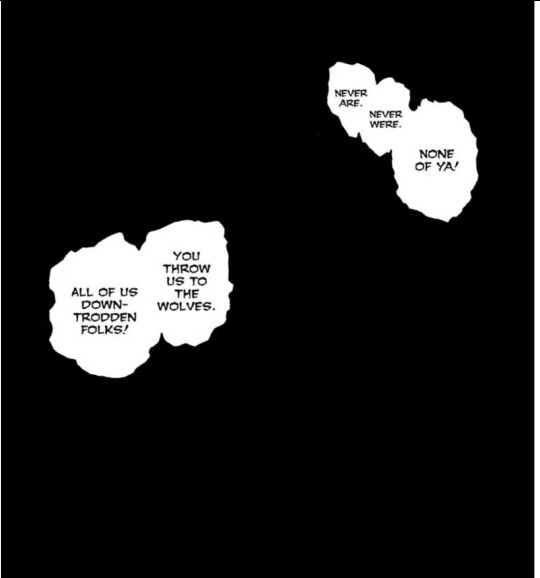


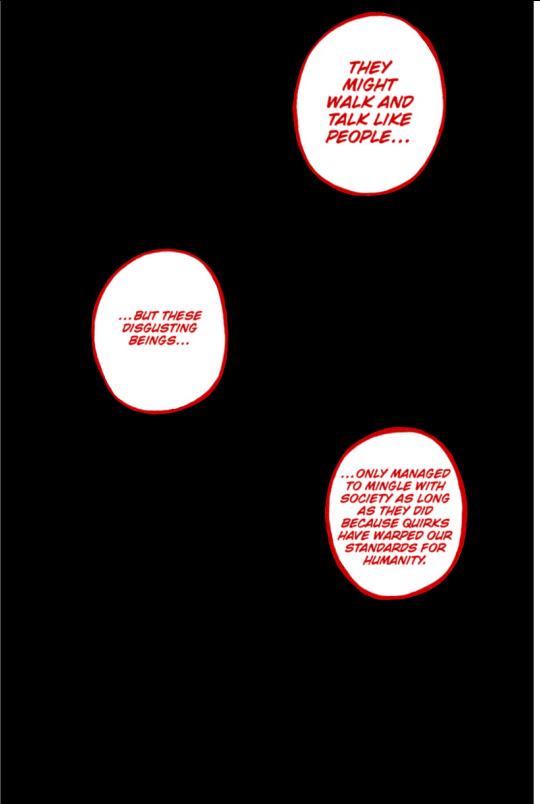
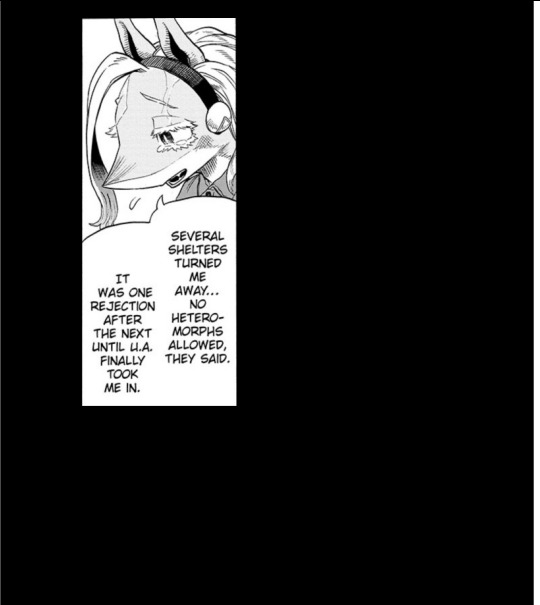






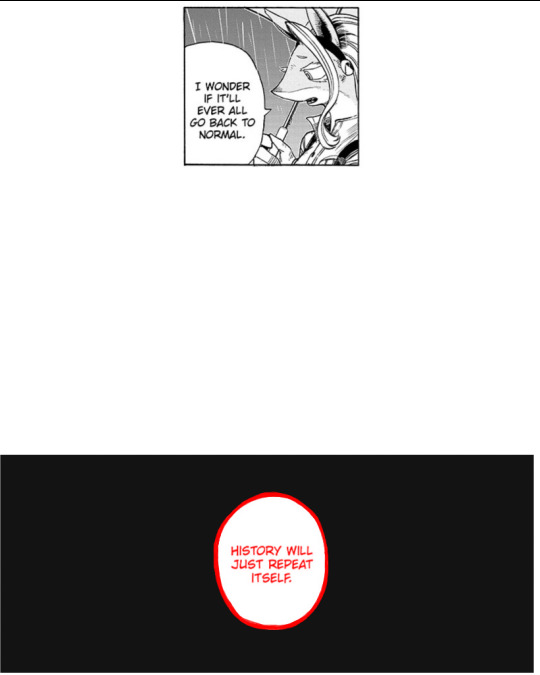


----------------------------------
Closing Thoughts:
o Even if AFO orchestrated Shigaraki's entire life, that doesn't change all the rest of this.
o Didn't use much of AFO, Harima, the MLA, and other historical stuff because the piece is supposed to be mainly about the problems in the here and now. The older problems linger, certainly, but I tried to only use the history angle when it was relevant to current problems, chiefly the immense suffering that motivated the hospital attack and the HPSC's willingness to circumvent the law in the name of the illusion of peace and stability.
o Thank you to my Translator Sis for her invaluable help in me learning how to use Medibang on the fly.
o Thank you to @codenamesazanka for the same as above and also for providing a number of scans for this piece.
o Thank you to my dear partner for the use of his enormous monitor, which allowed me to catch some transparency errors that otherwise would have gone unnoticed, and also for the shoulder massages and loving insistence that I take a few days off from this when my arm went on strike two weeks in.
o Thank you to everyone else for reading!
22 notes
·
View notes
Text
Bring It All Back (Part 3/4)
~A Tone Poem on Returning to the Status Quo~
Warning: IMAGE-HEAVY. A Webtoons-style vertical scroll comic using rearranged and recontextualized panels from My Hero Academia.
Deku keeps saying he'll bring everything back to normal. Hasn't he been paying attention?
(Part One)
(Part Two)
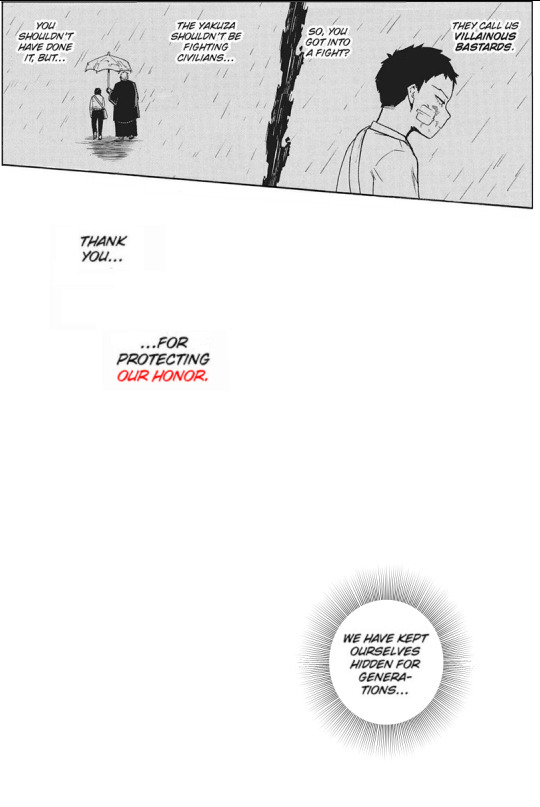
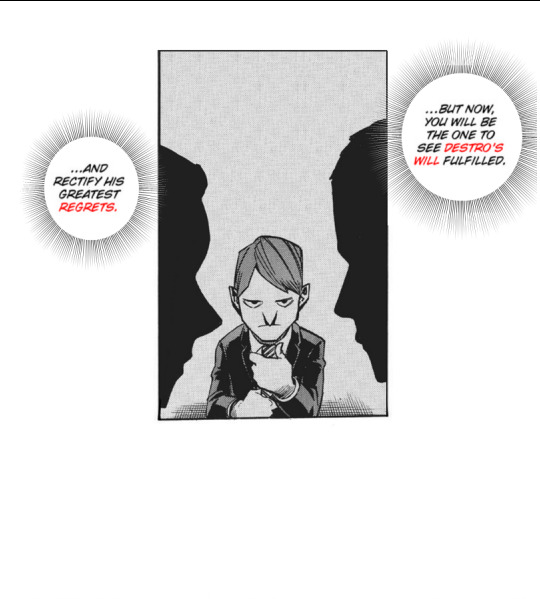



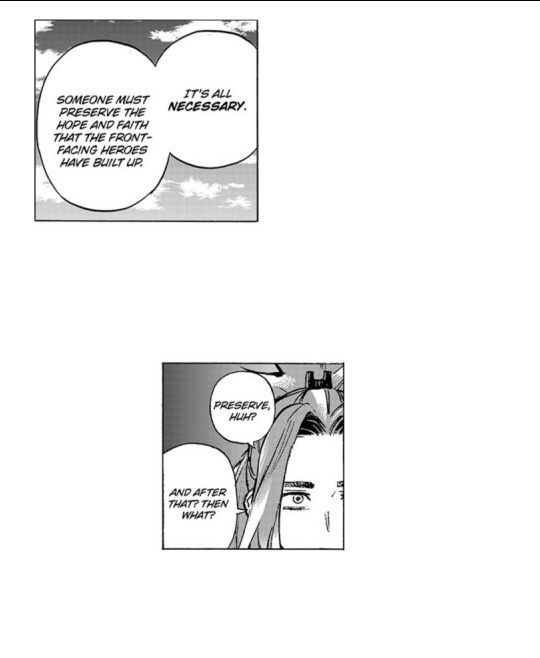
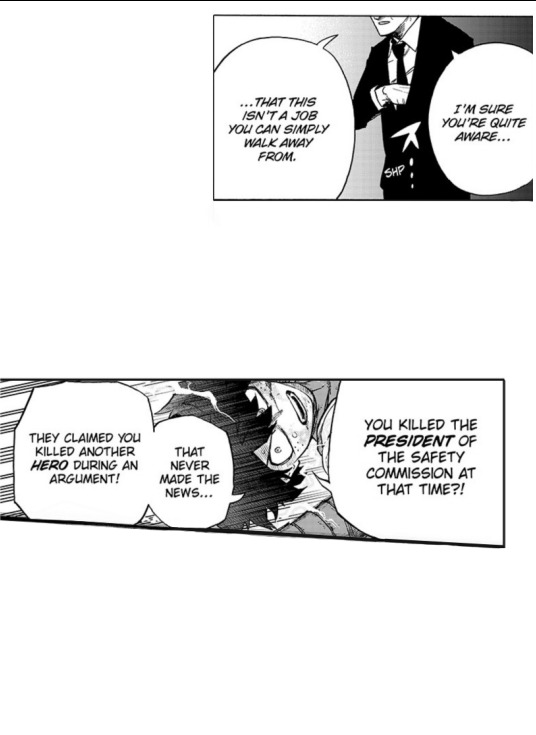











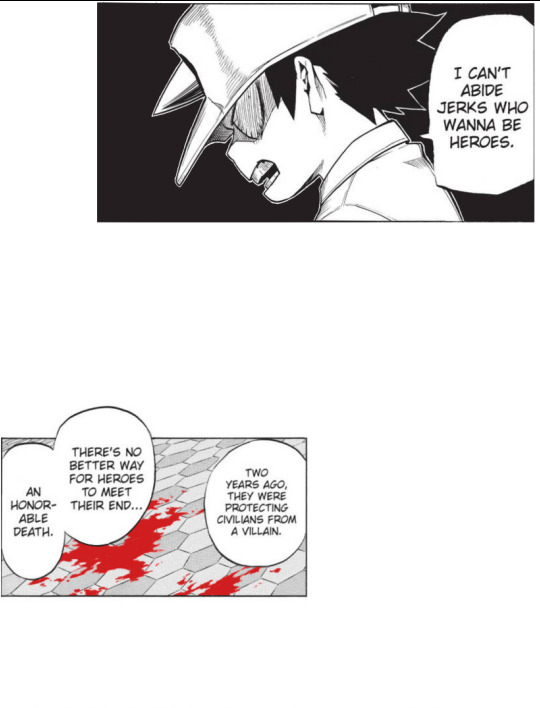


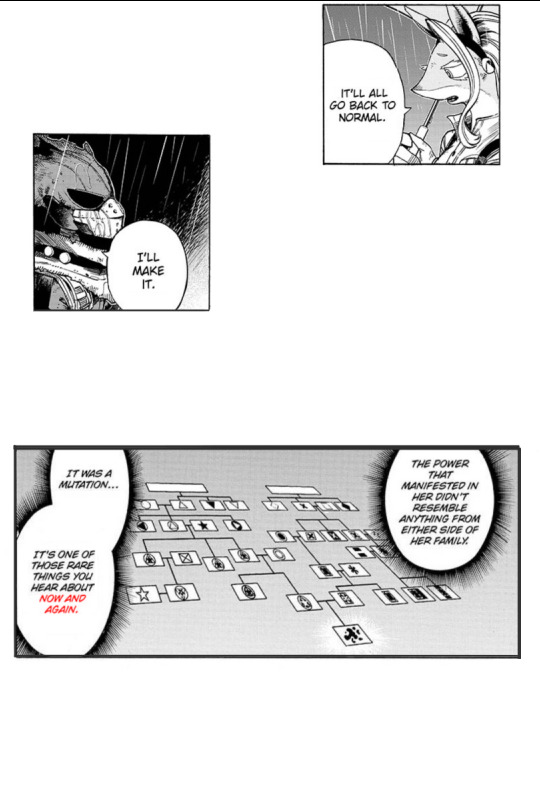
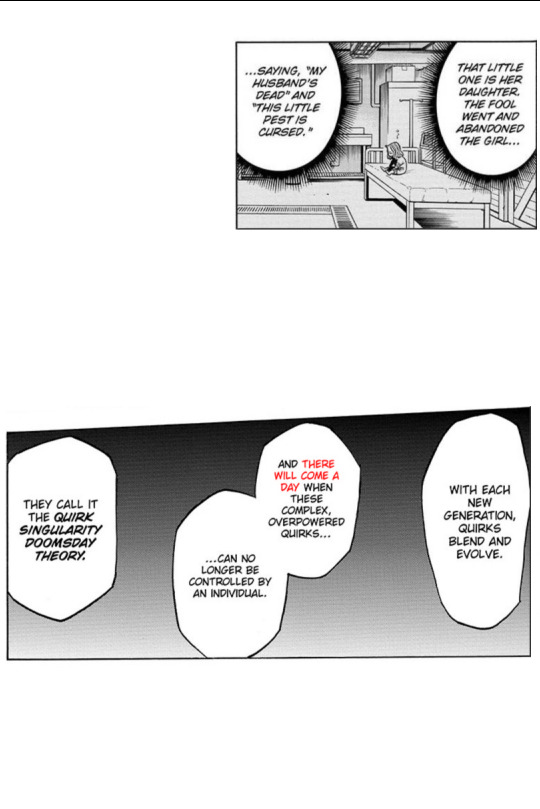



(Part 4)
#bnha#bnha tone poem#bnha critical#no. 2 green#lady nagant#class talk#gentle criminal#quirk singularity theory#my writing?
16 notes
·
View notes
Text
Bring It All Back (Part 2/4)
~A Tone Poem on Returning to the Status Quo~
Warning: IMAGE-HEAVY. A Webtoons-style vertical scroll comic using rearranged and recontextualized panels from My Hero Academia.
Deku keeps saying he'll bring everything back to normal. But is that really such a good idea?
(Part One)




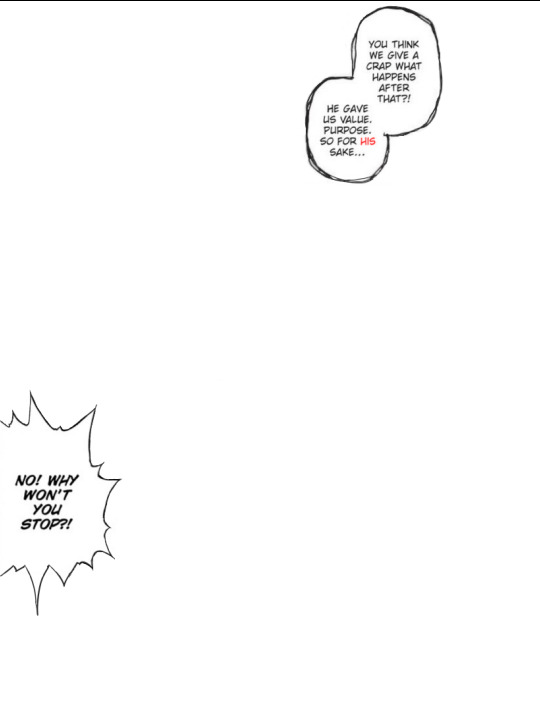


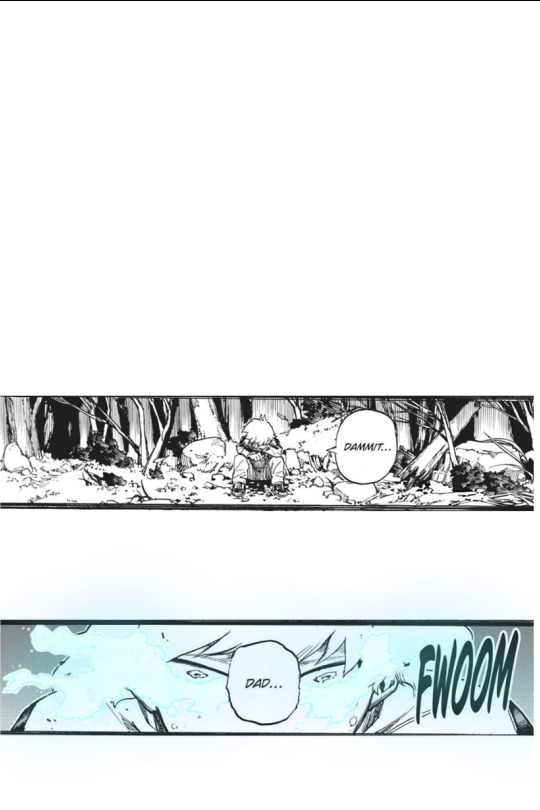

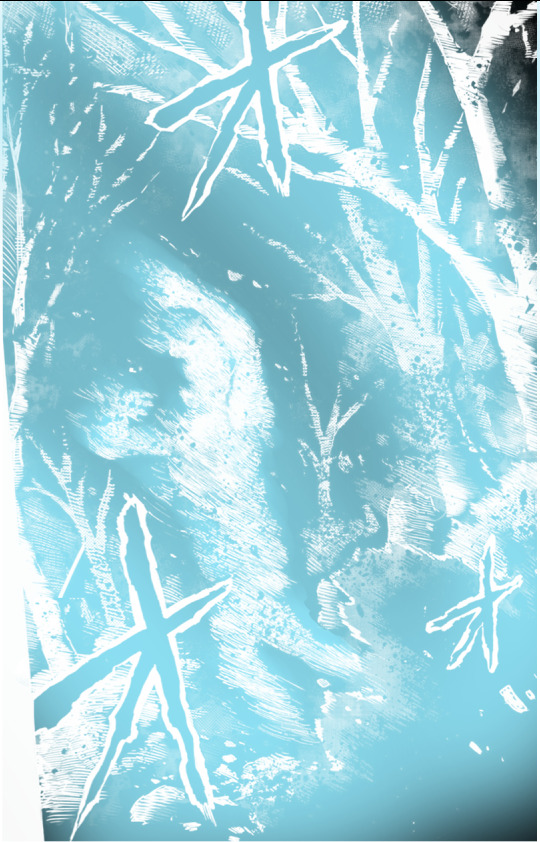






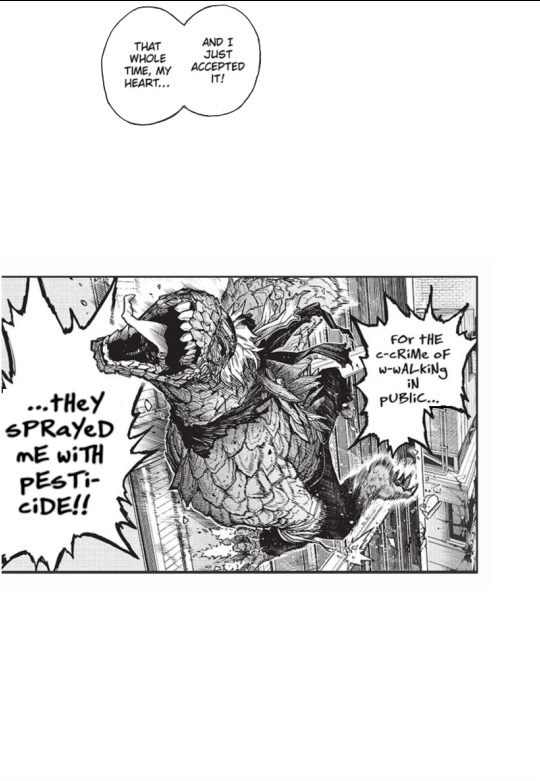

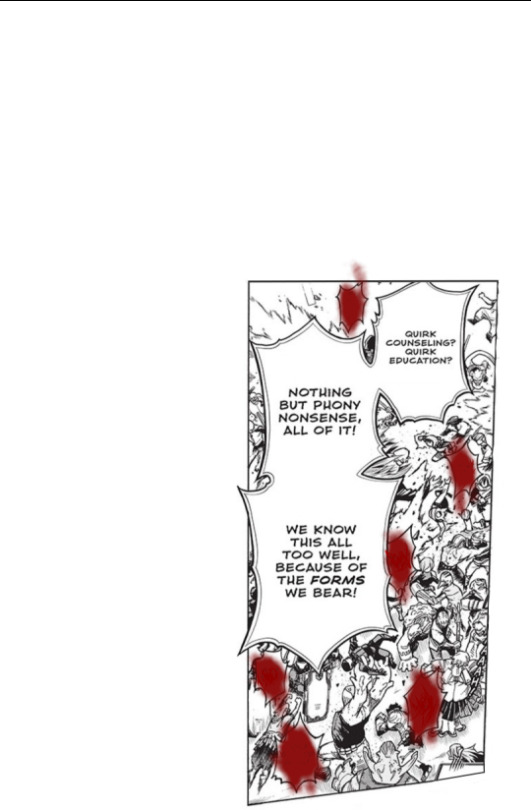


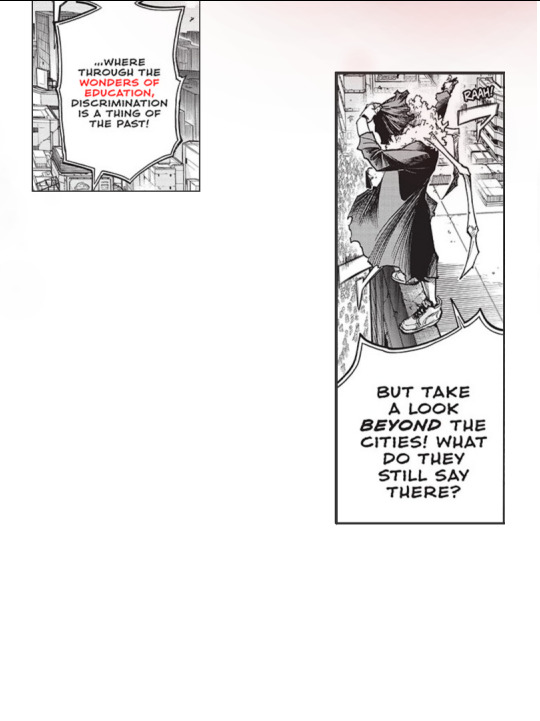
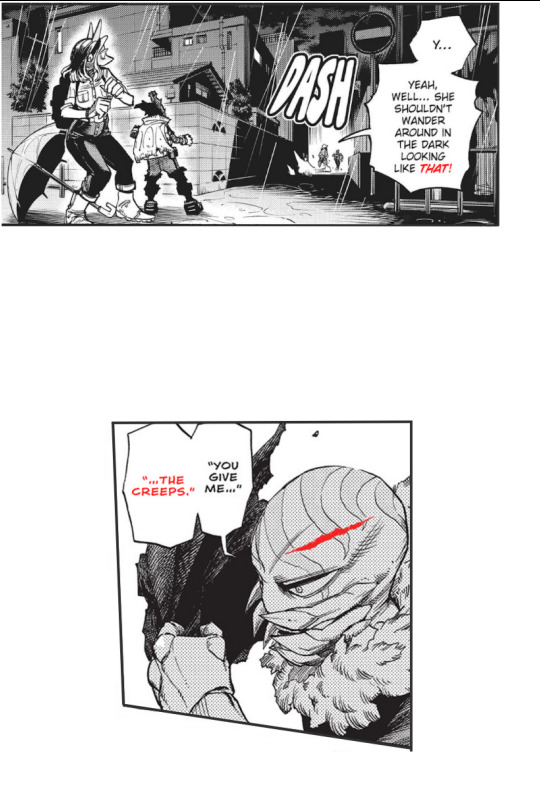


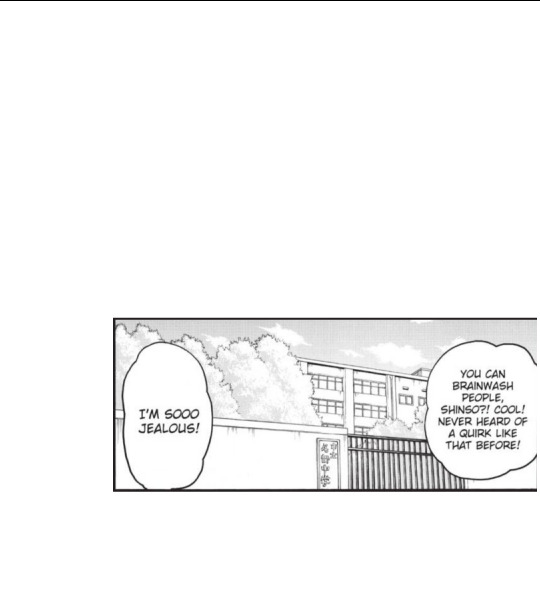




(Part Three)
#bnha#bnha tone poem#bnha critical#no. 2 green#shie hassaikai#heteromorph discrimination plot#purplezawa#my writing?
16 notes
·
View notes
Text
Bring It All Back (Part 1/4)
~A Tone Poem on Returning to the Status Quo~
Warning: IMAGE-HEAVY. A Webtoons-style vertical scroll comic using rearranged and recontextualized panels from My Hero Academia.
Deku keeps saying he'll bring everything back to normal. But what does "normal" actually mean...?

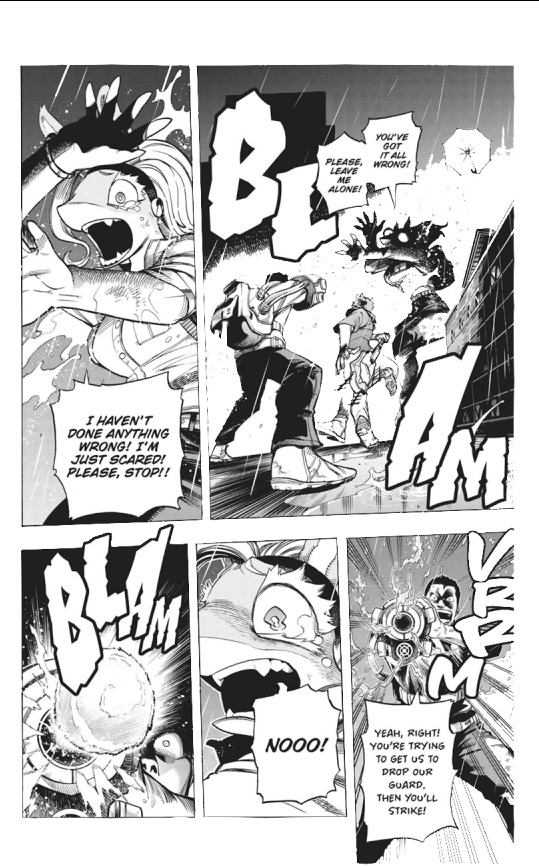










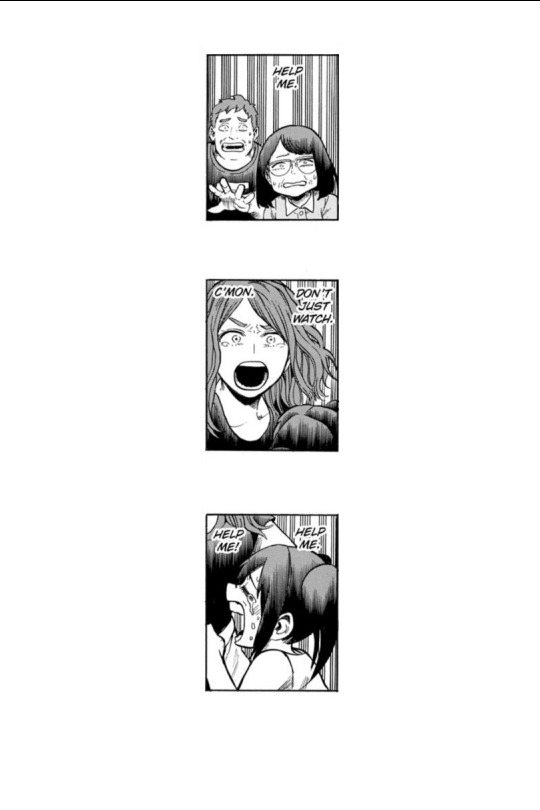

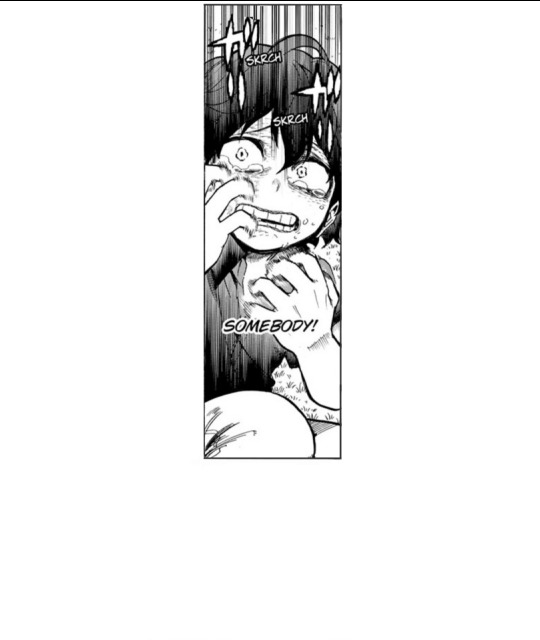

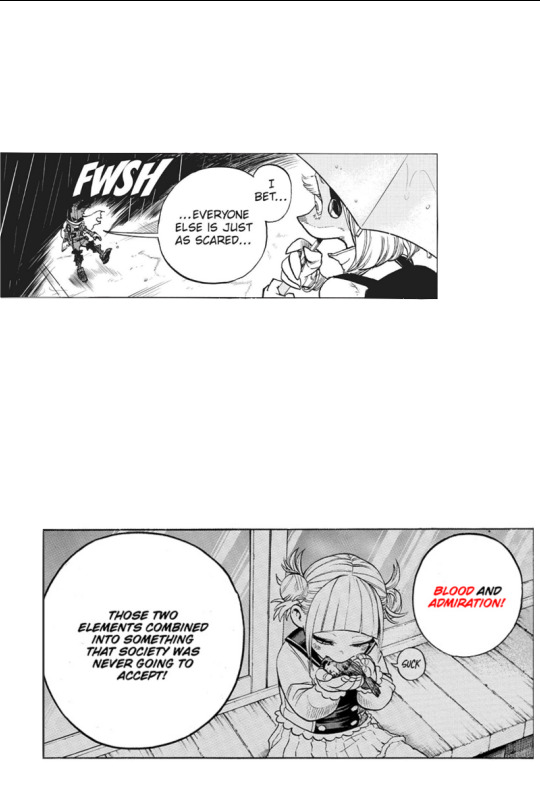
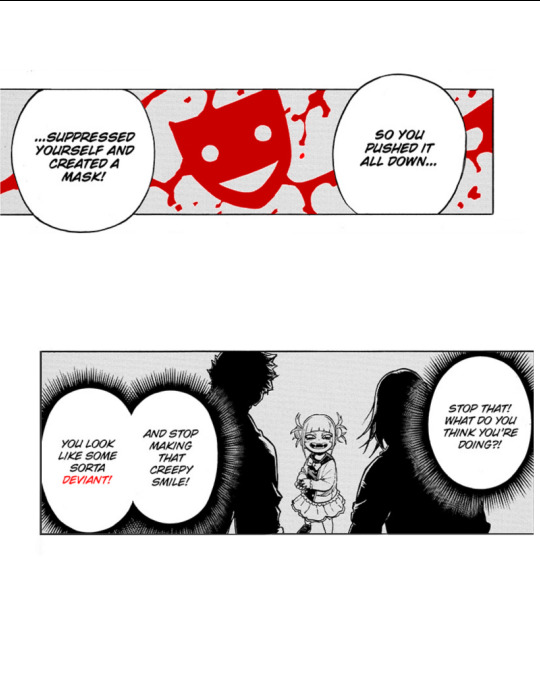

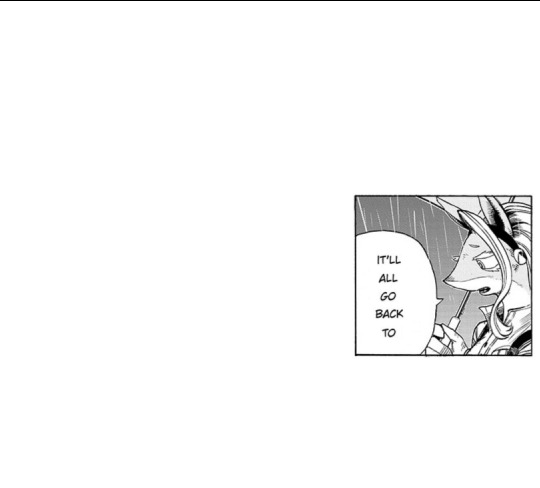

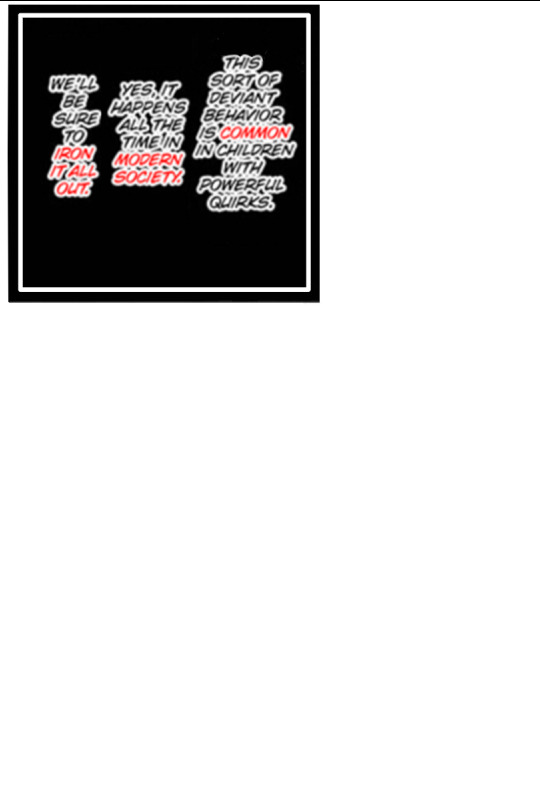


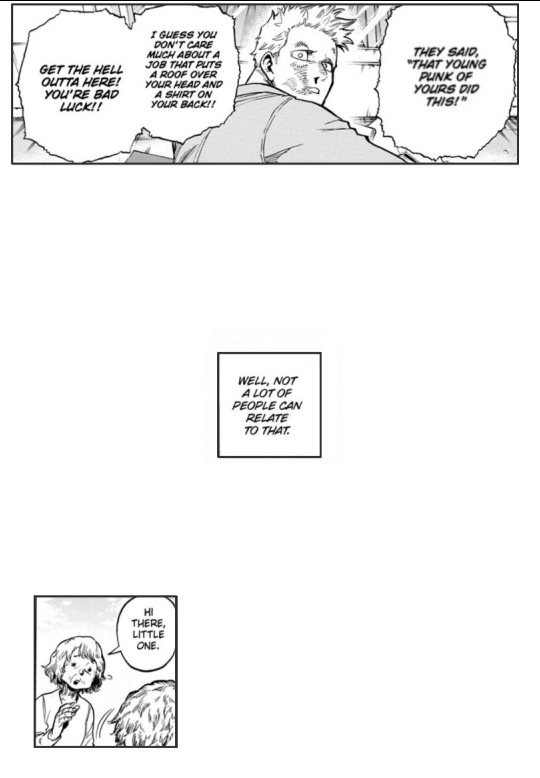


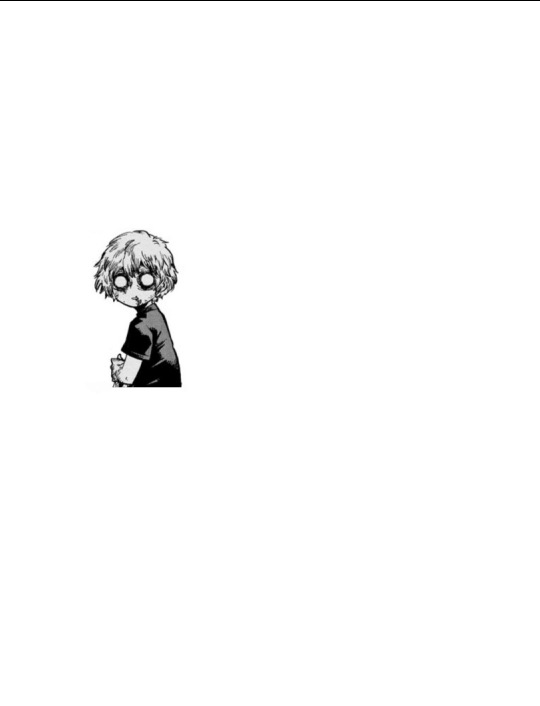
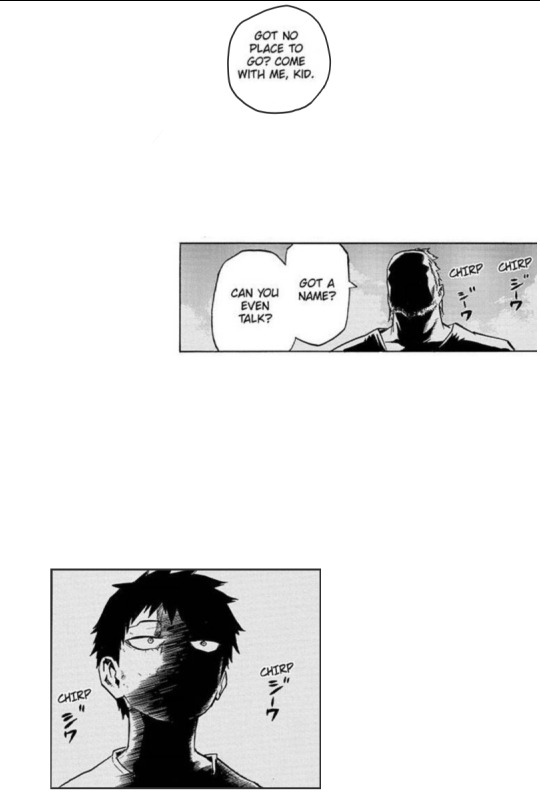

(Part 2)
#bnha#bnha tone poem#bnha critical#my writing?#no 2. green#bnha ordinary woman#shigaraki tomura#shimura family#toga himiko#bubaigawara jin#bnha overhaul
18 notes
·
View notes
Link
Chapters: 1/1
Fandom: My Hero Academia (Anime & Manga)
Rating: Mature
Warnings: Creator Chose Not To Use Archive Warnings
Characters: Midoriya Izuku, The Ordinary Woman (My Hero Academia), League of Villains (My Hero Academia), Shie Hassaikai | Eight Precepts of Death, Creature Rejection Clan (My Hero Academia), Meta Liberation Army (My Hero Academia), Tsutsumi Kaina | Lady Nagant, Tobita Danjuurou | Gentle Criminal
Additional Tags: minor appearances from other 1-a students, as well as family members and other civilians, Image Heavy, Vertical Comic, Arguing via Juxtaposition, recontextualizing canon, Fan Comics, (of a sort)
Summary: He keeps saying he'll bring it all back to normal. But what does "normal" actually mean?
---
Warning: IMAGE-HEAVY. A Webtoons-style vertical scroll comic using rearranged and recontextualized panels from My Hero Academia. Below the cut is a teaser. If you want to read the whole thing all in one go--which I encourage heartily!--please just go straight to AO3, where it can be read in its entirety, in slightly better quality and without the obnoxious divider lines between panels. If you want an idea of what it is, though, click the Read More below to see the first major chunk.
(The tumblr version of this--complete in four posts--will be up after a dinner break. I’m taking my life and integrity in my hands and posting this on spoilers night, come what may.)

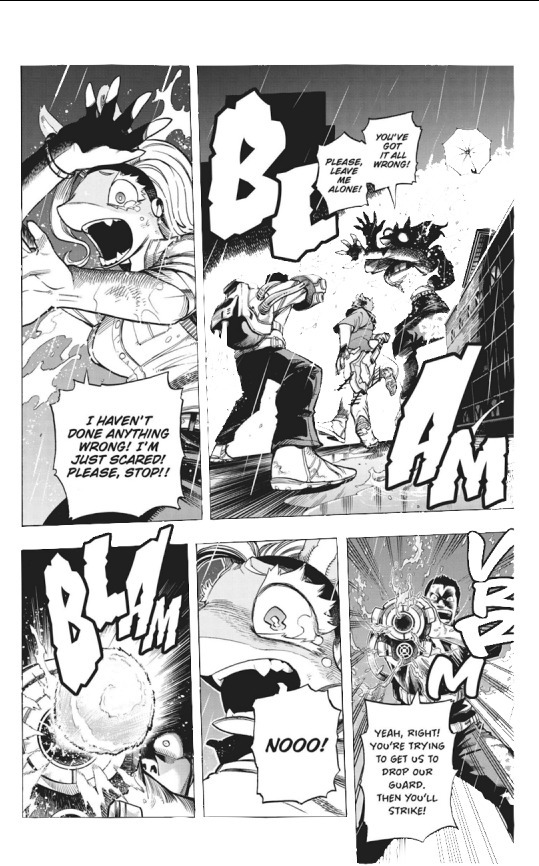
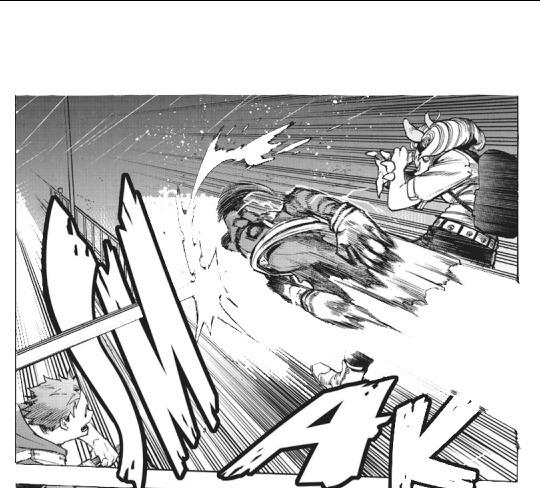
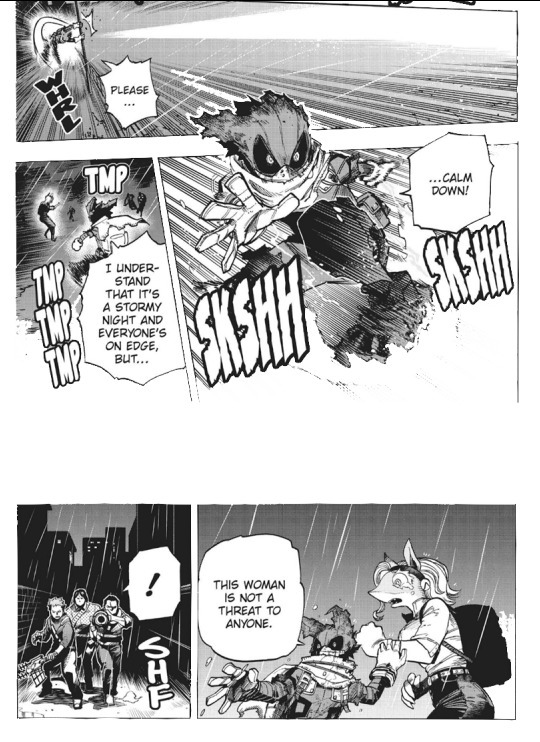
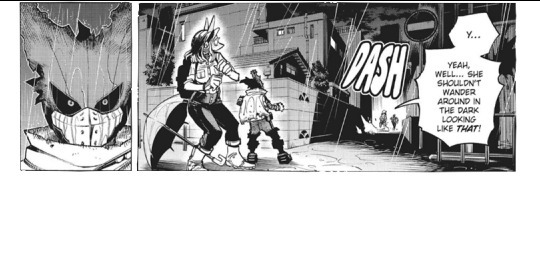
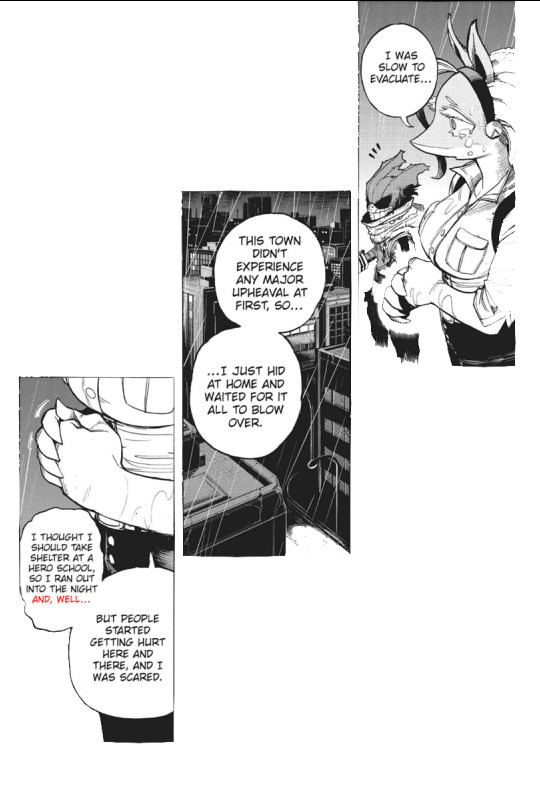




Read the rest on AO3!
15 notes
·
View notes
Text
Coming Soon: Tone Poem for the BNHA Status Quo
Sometime in the next 24 hours, I'm expecting to post a project I spent the last few weeks working on. It's pretty different, format-wise, than my usual stuff--instead of a written meta post, it's a Webtoons-style vertical scrolling comic consisting of rearranged panels of the manga (with some strategic splashes of color) for the purposes of making an argument via juxtaposition. The format is new, I say, but the argument will be a familiar one to my followers.
I make this post this as a warning that, thanks to the way tumblr manages images, I will be having to make several posts back-to-back to fit the whole thing; they'll be titled "Bring It All Back" and tagged "bnha tone poem." Please click through their View Post/Read Mores only if and when you are ready for some serious "Do you like the color of sky" levels of scrolling! I'll be crosslinking the installments to each other, so feel free to just click on whichever one you see first and follow its link to Part One.
That said, I'll be leading with a post containing an AO3 link for it with a short teaser covering the beginning through to where it first jumps the track. If you just want to read the whole thing all in one go (I encourage this most strongly; that's how I intended it to be read!) please just go straight to AO3. It'll also be at its native quality there, compared to the tumblr posts, which, from my draft experiments last night, will be just a little bit fuzzier.
I hope everyone will enjoy it in one form or the other! I first thought the idea up almost a year ago, but recently hit a patch of inspiration for it, by which I mean I obsessively worked on it several hours a day, every day, for two solid weeks. I, uh, kinda blew my arm out making it, in fact. Turns out that going 0 to 60 on using a stylus for a few minutes once or twice a month to hours of daily use has some physical consequences. Go figure! (I'm doing fine now, but that is the reason this project will be posting tomorrow instead of a week ago.)
12 notes
·
View notes
Text
One thing I think is potentially telling in this chapter is the way Deku is faced with the same questions Shigaraki has been asked the entire series: What is your conviction? Do you have a plan? What do you wish to build?
Shigaraki only had semi-formed answers for those questions at the time he was asked them, but he's grown over the course of the series into someone who can much more deftly articulate himself, even if his answers might not be what the askers want to hear.
But how about Deku? It always bugged me that the guy who just wants to destroy shit gets all this detail work demanded of him, while the kid who's being set up to lead the charge on improving the system he upholds is constantly allowed to get away with pleasant and undemanding vaguery, but here, he doesn't even have the vaguery - he says straight out to the phantasmal Overhaul that he doesn't have a plan at all.
If you wanted to be critical (and it's Deku, so I usually do), you could say the same for the questions of his conviction and what he wants to build. He has the strong but poorly articulated idea that he wants to save Shigaraki, but that idea is not so driving that he pushed back against the sky coffin plan to begin with; his Saving Villains conviction is also deeply erratic and selectively applied, which does not exactly suggest a well-thought-out, internally consistent Philosophy of Heroism.
Likewise, Deku hasn't addressed "what he wants to build" at all. Even if he gets all the answers he wants from Shigaraki (answers he insists on getting by violent boundary transgression, of course, rather than simply asking), he hasn't thought at all about what he's going to do with those answers, how he's going to apply what he learns going forward. In the face of Shigaraki's big-picture accusations, Deku is completely mired in small-picture thinking.
I don't buy the wishy-washy platitudes Deku can't be bothered to articulate to the people pushing him around the Hero Society chessboard, so it's nice to see Shigaraki refusing to settle for them either, turning the challenges he faced about his ideology into a challenge for Deku's ideology as well.
I don't know if it's the intended read of the chapter - it feels pretty pathetic to be here in the endgame, four hundred chapters in, with a main character who's only just now being challenged about what his goals are and how, specifically, he's going to achieve them! But it's an interesting parallel nonetheless.
Which is to say, circling back to the posts above, I do think Tomura is asking legitimate questions, and that those questions do require more consistent and detailed answers than Deku has yet afforded them; the callback to this particular running theme in Shigaraki's development arc really foregrounds both of those truths.
So I see conversation is still breaking down this week. Shigaraki’s asking very rudely what the hell Deku is even doing and telling him to die, while Deku’s giving us some of the most dialogue he’s directed towards Tomura this whole arc and it’s to tell him to get out of his way while he pokes around Tenko’s innermost heart & soul. (Honestly I'm still a bit troubled by how even now Deku's not really engaging with Tomura's talking points.)

Although to share my opinion: I’ve heard it said that Shigaraki is attempting to just reject Deku's attempts to save him like the jaded boy he is (not that he has been given much reason to trust Deku's intentions above those of the other heroes trying to kill him, hence the dark Deku appearing alongside Stain, RD, & Overhaul), but I disagree. Because are the things Tomura's asking not legitimate questions? Deku's officially given up all of One For All, all to see into a past that...Tomura's not been all that shy about sharing to begin with. The man’s had a motive rant or two every arc. What does Deku want to do now that he's here? Does he even know? Does Tomura have any reason to trust the intentions of this guy who disagrees with him on everything trying to pry his way towards his inner self to mess around with things?
No one can say, least of all Deku, because he is totally winging this in hopes he'll find a resolution this way. I can't much blame Tomura for being distrusting and hostile to all that. Wouldn't you be?
#also not to put to fine a point on it#but i was ALWAYS going to be on board with a chapter that tells me#that shigaraki holds his encounters with his villain foils deep inside his innermost core#they're so foundational they're standing in the fucking front yard of his childhood home#hell yes i want their presence there to be thematically relevant#bnha#bnha 417#bnha spoilers#shigaraki tomura#no. 2 green
156 notes
·
View notes
Text
I remember that! And yes, I'm still very eager to see what you came up with, particularly given the inverted ways Spinner has kind of risen to prominence in the story while poor Tsuyu steadily dropped out of it, to the point that she's pretty superfluous even to the plot she's in. (Seriously, if Horikoshi had really wanted Tsuyu to be a factor in Toga and Uraraka's plot, there is so much more he could have done with her, starting with paralleling Toga and Habuko.)
As to the contents of this post, I unsurprisingly have a lot to burble about. Hit the jump for me too, por favor.
O Right off the bat, I dig what you’ve got for Sato and Slidin’ Go. Like, you don’t mention Hawks, but the idea of SG dealing with feelings of redundancy and inadequacy plays right into Hawks arriving on the scene and immediately capturing Skeptic’s attention where Slidin’ might well have previously been the MLA’s highest ranked Hero! But how’s he supposed to compete with Hawks? I felt bad for him already, with those probable feelings of insecurity driving him to try and pull rank, only to get his chops busted by Skeptic, but in a version of his story where he joined the MLA specifically because of the inequality fostered by the Hero rankings, that becomes especially poignant.
And lord knows it’d be great to see more flaws and self-doubt from the 1-A students than we do; Sato is one of many perfectly apt candidates for that sort of focus. It’s particularly bad for him because he really is, other than Deku, the only one in class who truly has a strength-boosting quirk, yet it never gets any time to shine at all, because—like Iida’s speed—its combat effects (e.g. the only effects that matter to the series, by and large) can be replicated and surpassed by other, more versatile quirks.
O I wholly agree that Aoyama and Kunieda should have had more going on. While my personal bead on them is that Kunieda should have been the hand through which AFO maintained his grip on the Aoyama family (thus explaining Kunieda’s familiarity with Yuuga and giving Yuuga some familiarity in turn, at least with the flowers if not the face behind them), that’s certainly compatible with your idea of Kunieda’s striking loyalty to AFO! I do wish Aoyama had more complex feelings towards AFO than “terrified of him from Day 1, always knew he was Evil and Bad,” as Aoyama having his own feelings of loyalty he had to overcome on top of the cowardice would make the moral throughline of his decision to repudiate AFO stronger, but hey, in a rewrite, you can have that if you want!
It’s something I desperately wish the story/Deku would think about more in all cases: why, specifically, are these people so loyal to AFO? Positioning Aoyama to look at that, via both his own experience and what we learn about Kunieda through him, would be a good place to explore it (ideally in addition to similar depth given to the civilian moles, Gigantomachia, and Dictator). Also too, it means Aoyama doesn't just parallel Deku as a bullied quirkless child miraculously being given a quirk and using it to become a hero, it lets Aoyama parallel Yoichi as well, as a frail, weak, quirkless person with tangled feelings of regret and rebellion about the monster who gave him power. (That’s, of course, better suited for a story in which Yoichi maintained dignity and agency in the creation of One For All, tragically not the story we currently have.)
O Anything you can give Ojiro is wonderful, especially something that lets him answer the single damn joke the series has been making about him from the very beginning! Tail asphyxiation is good, and I like the metal absorption power because it highlights that Ojiro's very plain costume contains no metal for Fang to use against him (compare to the many, many, many other characters with metal accessories and ornamentation in their Hero outfits).
Might I also suggest that all that martial arts training means that Ojiro isn’t 100% dependent on his quirk in a fight? An extra prehensile limb, stronger, thicker, and more durable than the rest is great, but it also means he has all his regular limbs free to fight with—block counterattacks, engage in grapples, all that good stuff. I think Uraraka is the only other person in 1-A we really see engage with that sort of non-quirk-related subdual, and it’s often something people use to critique Deku: that he wanted to be a quirkless hero but doesn’t seem to have even so much as taken a friggin’ judo course to help prepare him for passing a Hero School entrance exam.
But then here’s Ojiro, plain old tail-having Ojiro, and he didn’t have to be taught combat arts on his internship (Uraraka) or in special after-school tutoring sessions (Shinsou); he started the school year already having that knowledge because he’s been diligent and deliberate about bringing his best to this from the start. Compared to people who depend solely on their flashy quirks, it paints him as more versatile, resourceful, and frankly more driven--and that goes for his classmates as much as it does Fang!
O I particularly love making Neptune a violent mutant rights activist, given that he’s one of the established Tartarus escapees, and Tartarus is not only an indefinite detainment prison for criminals whose quirks make them to be dangerous to hold via less stringent means, it’s also the prison you get sent to for disrupting the status quo. [Insert rant about Overhaul here, but I could mount the same argument about Stain and Lady Nagant.] Love everything about a conflict between him and Shouji being about finding a middle ground between the two of them, increasing the focus on mutant discrimination in the story prior to the endgame, and highlighting that the big problem with the heteromorph uprising in the final war isn’t the uprising itself, but them taking orders from someone who’s just using them for his own ends.
Really hope you do more of these! I like seeing anyone try to do better by this incredibly terrible endgame we're in, and I particularly like it when it involves humanizing the villains Horikoshi threw in without bothering to even pretend that they're going to get the same humanization and grace as the League villains.
Some Vain Attempt At Giving Every Member of Class 1-A (plus one more) a 'Nemesis' Pt. 1 of 3 - Jailbreakers...and Slidn' Go.
Now this is something that's been on my mind since like, what, a year now? Back before this blog existed a comment from @stillness-in-green asked why I thought Tsu should have been Spinner's 'Nemesis' instead of Shoji...
However, due to a combination of shyness, scattered thoughts and business, not only did I pretty much hold off on giving my thoughts, I also got hit with an idea that I'm both loving...and deeply regretting!!!
"Say, instead of just doing why I think Spinner and Shoji aren't a good match-up...why not give legit everyone in Class A (and a certain someone else), a Nemesis. Because what I'm doing isn't hard enough to explain as is!"
So I did, and have practically everyone else mapped out. What you see below are basically, most of the tertiary squad of Class A get their due facing against a Villain that I feel would be roughly on par with them and still be a meaningful clash (though not as important to those that got the League/upper MLA executives).
In addition, I added pretty much how I would write their 'arcs' so to speak concerning their clashes with these Villains. Nothing full blown, but just a bit of concepts had in mind that I feel would make their last battle meaningful.
Now, concerning these pairs I did have some rules going in place (because I can't make it easy in myself, why...) First rule is that the Villains chose have to be members of the League of Villains or its alliances. For example, Paranormal Liberation Front or whatever the Hell the Final War villains are called, are game. That said, I can't use Villains from spin-off or movie material, and Nomu's aren't allowed either (the former due to just wanting to contain things to the manga as much as possible, and the latter is more for balancing reaons).
Also, on that note, concerning the likes of Dabi/Shoto, Toga/Ochaco, and Deku/Shigaraki, they aren't going to be listed since...well, they're pretty much established enemies in canon! No real need to re-state them here. Also, AFO is hard locked to All Might if you were wondering, so he's not making an appearance here either. Neither is Gigantomachia or the Advisors (except one), due to balance and just being way too easy to fill up the roster with.
So with that stated, here we go!
Slidin’ Go - Sato
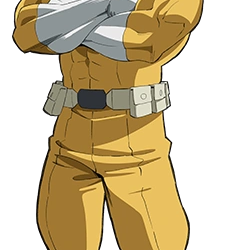

It’s speed vs power with this one, a match between the traitorous Hero who can, ideally, weave himself away from heavy blows against someone who can be stronger to take him down, but has to find a way to get that solid hit in.
Character wise, I want to imagine this being a storyline where Sato becomes insecure over his Quirk’s weaknesses and how unreliable he feels it might be. In a class where people can harness the elements, shoot intense soundwaves, and warp gravity - having a Quirk with a cognitive drawback and intense fatigue + being yet another strength Quirk would actually be a good way to explore the inner doubts of feeling redundant or unneeded.
As a foil to Sato, Slidin Go could be a Villain with heroic intentions at one point. However, Slidin Go was eventually overshadowed by speed/mobility Quirks that were functionally better (like Ingenium) and his popularity dropped to the point he became borderline poor given how low he was in the Hero rankings. S.G. joined the MLA as their man on the inside, in exchange for promoting him to rise higher in the rankings. Because, at his lowest point, all he cared about was just being able to sustain himself. The price to pay for being seen as redundant and how he sympathizes with Sato.
Assuming this takes place in a timeline where S.G. is participating in the Final War, Sato thinks outside the box to best S.G. With the last of his cognitive strength, he shatters the ground to trip SG up before taking him out in one strike. Sure, his Quirk might be ‘redundant’ in the face of others, but what matters in the moment is not caring about one’s status but doing the right thing, in spite of it. A lesson that Slidin’ Go forgot long ago...though maybe, in time, after his arrest he can regain that spark?
Kunieda - Aoyama


Now this is one that, really, already played out in the manga, but will restate it here briefly since there is an interesting dynamic here, if brief. Aoyama and Kunieda offer a unique spin on the ‘loyal ally versus the traitor’ plot. Aoyama is the Traitor, a double agent for the Villains that goes against them for the bonds he made undercover and to make up for his wrongs. In contrast, Kunieda is someone actually loyal and grateful to All For One - his liberator (heck, one of the few that seems to genuinely be loyal to AFO in the Second War) and hates Aoyama for switching sides. It’s to the point Kunieda personally wants to kill Aoyama just to keep up AFO’s streak (which, to me, gives credence to Kunieda being a former associate to AFO and not just a random Jailbreaker).
In media, I always found it interesting when the heroes are people who betrayed their former allegiance for someone else, and their rival end up being someone fanatically loyal to their old group. I think its because, if alignments were reversed, it’d be easy to portray the Traitor as being self-serving and cowardly, compared to those who remain whose loyalty to their boss who would be seen as virtuous. Given both of their personalities, with Aoyama actually struggling with cowardice and Kunieda being fiercely behind AFO, its not an unreasonable thing to consider at all.
Here? It’s pretty much saying that not only is it okay to betray someone who you work for, if they’re as toxic and awful as AFO, but the virtuous thing in this instance is to go against them to save others, with loyalty to the ‘boss’ being a vice that’ll just bring you down. If I were to make their fight stronger storywise, perhaps Kunieda could have been someone that got the better end of AFO giving out Quirks. Perhaps, he was also Quirkless or had a weakish Plant Quirk before running across AFO one day. In exchange for the Quirk he currently had, he swore loyalty to AFO to be a supplier of corpses for him, before being arrested by Endeavor.
Gashly - Sero
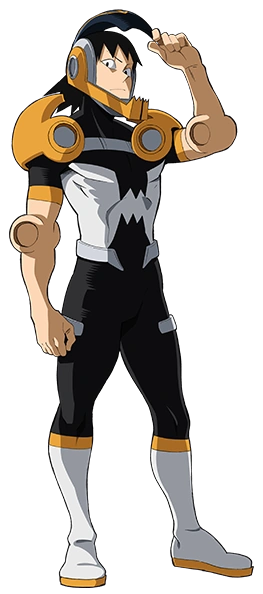

At the time of this writing, Gashly is likely slated to be Sero’s opponent. Can’t really get into too much specifics since I don’t know how that’ll play. So I’ll just give brief thoughts on why I think they’ll work, how I’d write Sero to make it evern more appropriate, and what Gashly deal might be.
Sero is the laidback, witty guy of the Class A who provides support and levity to his allies. In contrast, I imagine Gashly to be the type that only wants levity for himself in the form of his crimes: making twisted stories that involve brutal deaths of kids. If I were to write Sero’s arc, I’d probably make his jokey side both his reason to be a Hero and a bit of a front for insecurities of people taking ‘the guy who shoots tape’ seriously (especially after Shoto beats him in the Sports Festival). His victory against Gashly is him proving to the Villain and himself that it’s far more of a threat than people give it credit for.
For the Top Ten that beat Gashly before, I want to imagine Ryukyu did the deed. A fantasy creature Hero beating a storyteller is just fitting.
"Fang"/2nd Hired Gun - Ojiro
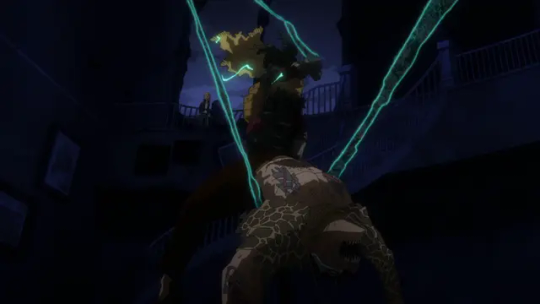

Yep, its Ojiro against the second Tartarus Jailbreaker AFO sent after Deku…who got his ass beat so very quickly. Name and power? Nope - just a reminder that Deku is so OP now not many can compare, because that certainly helps brings out the threat of even escaped criminals. Distaste aside, Fang (for lack of a better name) was chosen because, design wise, I feel a gangster type contrasts well against Ojiro being a disciplined martial artist.
Ojiro always had to face people criticizing for fighting ‘plainly’ with his Tail Quirk, and his own arc here could be accepting that, yeah, while not as flashy, as his peers, his Tail is more versatile in its simplicity and incredibly effective. Fang, as a dark reflection, could be what could have happened if Ojiro had a ‘flashier’ Quirk and let the fame of it go to his head. Since he’s a Tartarus Jailbreaker, and had quite a bit of jewelry on him, I’m going to give him something like a Metal Absorption Quirk. Something that, in theory, could pose a problem to Deku (if Fang didn’t get his ass beat so quickly). Whatever metallic substance he touches, his skin reflects it. In this case, befitting his chain around his neck, he skin becomes gold. I like to imagine Fang was originally overconfident and based too much of his pride in his Quirk. So much so that he was a bully that turned to a life of crime as head of his own crime gang. A gang that I imagined was stopped by one of the Top Ten heroes like Edgeshot.
Fang’s downfall, assumign he made it to the Final War, could be that arrogance biting him in the ass. He’s so cocky he fails to realize that, while Ojiro can’t necessarily hurt physically due to his Quirk, he can still use his tail to take him out by other means. Such as restraining Fang and knocking him out by suffocating him with his tail. Is Ojiro’s Quirk flashy as the others? No way, but he doesn’t need for it to be flashy to be effective. He just needs a chance to make that ‘plainess’ work extremely well for him. Leading for Fang to once again be defeated by someone both more humble and creative than him.
Dictator - Hagakure


It’s everyones least favorite clown villain - Dictator! But now he gets to face off against our perky spy!
So what would Hagakure’s storyline be for this? Before Sato and Ojiro's dealt with issues of the world such as feeling of being Outclassed or Plainness. So I figured an interesting contrast for Hagakure is to deal with personality and powers not really mixing. Her arc could be struggling to be an efficient espionage Hero when she longed to be in the spotlight, getting praises and such from the crowd like her friends If I were to rewrite the story, Hagakure's personality would be tweaked to be more of a cocky type, inspired by her bout of overconfidence during her 1B battle.
Early on she'd be extremely boastul & playful concerning her invisibility, blinding her enemies and taunting them throughout her fights...up until people eventually wisened up either by paying close attention to her voice, laying traps to trip up Hagakure or just using AOE moves if they had it. I could see another change could be that she might volunteer to go after Mustard in the Training Camp attack but ended up losing because she overestimated her own ability and her cockiness gave him an opening to knock out her out. Following that, her training under Yoroi Musha could be to grant herself more discipline and find different ways to channel her mischeviousness into being a better spy - one that can get a victory worth celebrating for and cheers at that!
So how would this relate to Dictator? Well, given his Despot Quirk and clown theming, I’d expand on this short guy as him being a ringmaster that wanted to put on the best show in Japan…problem is that he forcibly recruited/enslaved those he saw potential in his ‘circus’ via his Quirk. He’d trained them to Hell and back under very dangerous performances, up until an investigation was enacted. Something that lead to him taking over everyone, cops who came to arrest him and panicking audience, until Crust defeated him. In short he’s a tiny fella that wants to be in absolute full control from start to finish.
A control freak to the core against someone whose a master of surprise, it works out surprisingly well. For their fight, and to show how Hagakure’s grown, she’d silently wallop Dictator who’d be in utter panic over getting hit by seemingly no one. Enough that he loses his grip on Despot and release his prisoners by accident. Thus, giving Hagakure enough time to blind him before knocking him out with an uppercut…and celebrating with an appreciative audience for good measure.
"Neptune"/Hired Gun No# 3 - Shoji
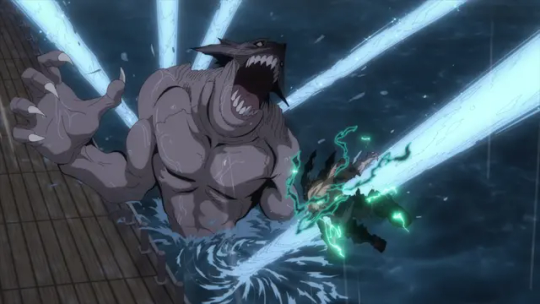
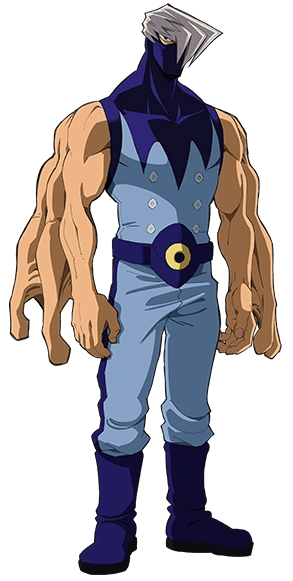
Finally, Shoji would have Neptune, for lack of a better name, as his Rival for the War fight. Now, why? Especially given that Shoji was meant to reflect Spinner. Now, on this end, I have said I disliked their pairing and I think that reason has to do with importance at the end of the day. Storywise, meaning. On Spinner's end, on the Villains side, he's had load of character development from his beginning as our lovable Stain cosplayer, to reluctant leader just trying to help out the one who cares about most. It's actually a remarkably clear and steady growth that leads up to his role in the Final War...
Yet, his Rival in this instance is Shoji. While Shoji's whole arc did have a few crumbs (such as his Pony fight), let's be honest he hasn't had any near enough importance or build-up in the story that really feels earned to be Spinner's Rival, nor do I feel that, given both of their roles in their respective groups, do I think they made even a natural match. Neptune here is meant to be a substitute for him that gives him a climatic finish and Spinner someone different to butt heads with (and will it be Tsu still?! Who knows!!!!)
Neptune here would be a mutant rights activist, though was dubbed a Villain after his protests involved taking a violent stance against those that harmed him and his shipping crew. In his case, I imagine Gang Orca was the one to defeat him, and given Gang Orca’s whole deal with being considered one of the scariest Heroes, Neptune might consider this a betrayal from someone in the same boat.
His role in the Final War arc would be assisting in the freedom of Kurogiri, and intercepting Shoji. Neptune would be the stance of physical rebellion - that change can not occur unless those affected fight back physically and showing their discontentment. Shoji would represent emotional rebellion - that change can not occur unless you show others by your character that you are different. Both aren’t really wrong in their ideals or their feelings on the matter, but it's Shoji that recognizes that working under All For One, someone who has no one but his own interests in heart, is not going to give the Heteromorphs the better treatment that they yearn for.
For Shoji's character arc in particular, I would change things so that the Heteromorph discrimination would be more out in the open in UA, likely in a history class that covers the great Jeda purge or 6/6 incident, and him being a bit more vocal concerning the reputation of mutants. Have it be a case where the class, naturally, is disgusted by such genocide, but seemingly think that its just a case of evil in a bygone era…up until its Shoji who ends up doing a report on just how many Heteromorphs make up the majority of the arrests in Japan kind and victim reports out in the slums, boonies and even the case of the cities they thought were safe from such prejudice. He isn’t condemning them for not knowing, but it is his words that get them to consider how they’ve been acting towards those who were like Shoji so far (like Shoto and how he treated the police chief). Just something to help boost the plotline a bit more.
I also think Neptune just fits with Shoji given their sea animal/monster theme, too. As for their fight, I imagine it’d go similar to Spinner fighting against Shoji, although in this case, I imagine Neptune’s need for water might eventually make him lose a battle of attrition against Shoji in the end. Though compared to Dictator or Fang, he’d be a Nemesis that Shoji does actually succeed in getting him to stand down and possibly even get rehabilitated for the future.
-
But, yeah, this has been the first part of the series, so far. Hope its been at least an interesting read through, and these match-ups make sense from your views.
I was very conflicted when it came to giving these guys Nemesis since they didn't really fit/other people in the Class were more fitting to get the likes of the League or MLA guys. I originally was going to pair the likes of Sato, Ojiro, Hagakure and Shoji with the High End Nomu, but a combo of the realism concerning them facing one, and just feeling iffy on them had me scrap the idea and put up the Nomu rule in effect. I wanted the Villain they face to not really be a monster like a Nomu.
I also did toy around with the movie stuff, namely the Heroes Rising Villains coming into play, though it would have been just Shoji, Hagakure, and Ojiro going against Chimera, Mummy and Slice, but figured it'd be best to stick to just the manga.
If you're wondering about Slidin Go', he's like the only exception to the Advisors showing up here due to being a thing before the group. He also was supposed to be who remained of Sato, Ojiro or even Sero as like a filler choice if I couldn't find a suitable villain. Sato happened to get the short end of the stick. SG is also here because still writing about the MLA guys, who are next, and had his completed first.
I actually had Hagakure locked into facing Mustard, but once it hit me to use the Jailbreakers, thought it'd be best for Mustard to face someone with more story importance and who could be a better contrast too. Aoyama was considered to but it felt awkward for me.
Here's hoping the next part comes out soon...or at least this year!
#bnha#other peoples' meta#plf advisors#tartarus escapees#listen kunieda should have been the nightmare of aoyama's childhood#they should have been digging bodies out of his mother's European rose garden twice a year and having to buy their gardener's silence#GOD
23 notes
·
View notes
Text
To Those Left Behind: Answering the anger of the survivors in My Hero Academia vs. Hosoda Mamoru’s Belle
Yes, it's another "What [X] Did Right That BNHA Is Doing Wrong" post. I'm not trying to make this a series, but what's a girl to do when everywhere she looks, she sees other stories that are handling elements of BNHA's endgame with far more grace and rigor? Hit the jump.
The Formula: The Hero vs. The Critic
A bugbear of mine in superhero fiction is when The Hero is presented with someone critiquing their heroism who immediately revokes their objections when The Hero saves them in turn. The basic shape of the story is as follows:
The Hero is confronted by The Critic in some situation that lacks immediate danger. The Critic has issues with The Hero’s day-saving activities. Perhaps in some earlier battle between The Hero and Some Villain, The Critic suffered property damage; they might also be an innocent bystander (or relative thereof) who was harmed in the fight. They might simply be a stickler for laws The Hero may or may not be acting in accordance with. Perhaps they even take issue with the suffering Heroes themselves endure, though in the case of this specific storyline, they’re more likely to be thinking of a different Hero in their lives than the one they’re actually confronting.[1]
The Critic presents an obstacle to the combat-focused method that is superhero fiction’s default mode of conflict resolution. They may endanger The Hero’s activities by threatening legal/institutional reprisal, or they may just be there to make The Hero feel bad about themselves. The Critic may be framed very sympathetically by the story, or they might simply be a buzzkill, but regardless of the degree of empathy the story chooses to afford them, they are a hurdle to be overcome.
The Hero is unable to cogently argue for their own position because superhero narratives are not about offering real life justifications for vigilantism. Rather, because the default mode of conflict resolution in a superhero story is being a superhero, the story circumvents The Critic’s objections by placing them in danger, offering The Hero a chance to save them.
Having thus been personally saved by The Hero (or, to put it more cynically, having personally benefitted from what The Hero does), The Critic promptly gets over all of their objections, even the ones that seemed to have been founded in well-considered ethical frameworks rather than traumatic experiences.
1: “Hero’s civilian loved one has a problem with their heroics” is a whole different story! Typically that story is used to mine for drama in The Hero’s personal life; if it’s not there to serve as an ongoing relationship stressor, it’s more likely that the civilian loved one will get over their objections as a result of seeing The Hero save an uninvolved innocent than because they are themselves directly saved by The Hero.
This, to me, is simple sophistry. “You say you don’t approve of what my saving people costs, but what if I saved you, huh? Then would you like me?” is a cheap gotcha that relies on The Critic being incapable of separating rational ethics from their direct experience. That’s not to say that ethics shouldn’t have a foundation in lived experience, of course, but one also can’t de facto rely on one’s emotional responses to dangerous, traumatic situations to guide e.g. public policy. Emotional responses are not inherently fair; they can be myopic or prejudicial. For the same reasons of impaired partiality that guide judicial recusal or juror screening, a single personal experience with being saved by a superhero cannot be assumed to write superheroes a blank check for everything they do while in costume.
And yeah, I realize that I’m being ungenerous here. I assume that the storyline above is meant to be read as The Critic lacking sufficient empathy for those The Hero saves and coming to a greater understanding of the terror and desperate need experienced by bystanders when Some Villain attacks. I can understand the general thrust of things!
Still, that story structure does not require The Hero to grow—all they have to do is endure and keep doing what they’ve been doing all along. All the growth is experienced by The Critic as they’re led to empathize, not with The Hero, but rather with the other underdeveloped side characters—or more likely bit characters!—The Hero saves. And even that empathy is usually less spotlighted than The Critic’s gratitude, which can feel especially distasteful when it feels like the story is emphasizing how noble The Hero is for saving this jackass Critic that’s been giving them so many problems, and isn’t The Critic just so thankful now that they’ve been humbled and shown the error of their ways?
It’s not a story that, to my eye, usefully challenges The Hero or The Critic, merely a self-serving narrative that assures both The Hero and the audience that The Hero Was Right All Along. I can see the appeal of the “No, you move,” flat arc as much as the next person, but that story just feels like, if you’ll forgive my crudity, setting The Hero up for easily-earned asspats.
Let’s look at some different permutations of the formula as it appears in My Hero Academia.
The Critics of My Hero Academia
Over the course of its 400+ chapters, My Hero Academia portrays a lot of criticism of the state-sponsored Pro Hero industry the story depicts. There are people who criticize the laws that form the basis of professional heroics, people who think Heroes work too hard, people who think Heroes don’t work hard enough, people who think Heroes are too commercial, people who think Heroes are a shiny façade over a corrupt and ugly reality, people whose way of life has been ruined by the rise of Heroes, and on and on.
Unfailingly (and often to its considerable detriment), the flawed but valiant Heroes of My Hero Academia continue to uphold their system and their activities as valuable, admirable, and—most crucially—the only reasonable solution to the problems created by the superpowers wielded by the setting’s inhabitants. Any Critics they face are destined to be proven wrong; neither the Heroes nor the author have any real desire to explore meaningful alternatives to the Hero System. Many of its Critics are thus presented as cynics operating in bad faith or outright Villains who only resent the Hero System because it makes their criminal activities harder!
However, there are Critics who are treated as more valid by the narrative: those whose objections to Heroism are rooted in the family bonds and/or love and care they hold for specific Heroes. It’s this type of Critic—and MHA’s response to them—that I want to look at in more detail.
> Case 1: Izumi Kouta
Kouta is the single most clear-cut example of the “The Hero saves and thus convinces The Critic” narrative the series has to offer, as well as foreshadowing much more extreme damage in other characters the audience will meet later on. An orphaned child whose parents died in combat with Some Villain, Kouta has grown resentful of Heroes and surly towards the society that worships them. He doesn’t understand why a bunch of strangers were so important that his parents would choose to prioritize those strangers over their lives with him. Deku The Hero has no idea how to address this, and therefore roundly fails in his first few attempts to verbally engage with Kouta.
It’s not until Some Villain[2] shows up to menace Kouta with the threat of gruesome murder that Deku’s able to connect with him. Note how this scenario puts Deku back in his comfortable heroic wheelhouse. Sure, he breaks a bunch of bones in the process of fighting Muscular, and it hurts a whole lot, but beating Muscular does not require Deku to triumph in an ideological battle; he simply has to be the best at Punching Really Hard. It’s quite straightforward and simple by comparison!
[2] As it happens, the same one who killed Kouta’s parents, but that’s an incidental detail; the narrative would have gone the same way with any Villain who was willing to threaten the life of an uninvolved child. My Hero Academia simply has a surprisingly low number of Villains who fit that criteria.
Does being the best at Punching Really Hard actually address Kouta’s ideological problem with his parents choosing Heroism over being with him? Well, no. Kouta simply pivots into idolizing Deku and never brings up his parents or his trauma surrounding their deaths again. Having come to understand how much it means to be Saved, Kouta gains a new appreciation for the value of Those Who Save, but this valuation is entirely focused on the Hero who saved him, without resolving the question of why said Hero is valuing the life of some stranger over his own familial bonds—and whether it’s correct for The Hero to do so!
My Hero Academia simply doesn’t care about Kouta as anything other than a vehicle for allowing Deku to feel confident and proud in his chosen career, and thus its portrayal of Kouta as Convinced Critic fails to escape the clang of intellectual dishonesty so frequently present in narratives of the type.
Sidebar—The Case of The Critic as Family:
Midoriya Inko Inko’s opinions on Deku’s heroics present an obstacle twice, with the former instance being much more compelling. Her confrontation with All Might is much closer to the “Hero’s civilian loved one has a problem with their heroics” story I mentioned previously in a footnote, but with a major shift that pushes her closer to The Critic’s role: Deku’s age. If Deku were an adult, Inko’s objections would simply be fodder for relationship drama, but him being a minor means Inko has a degree of parental authority she’s capable of wielding in his life—over his objections, should she choose! This allows her to pose a very direct threat to his further ability to engage in heroics.
In the end, however, the obstacle is resolved in mostly the standard way of the loved one objector. Deku’s prior rescue of Kouta—and the fan letter Kouta sent him as a result—is used to prove firstly the value to others of Deku’s Heroism and secondly the personal fulfillment Deku derives therefrom, leading Inko to back down after making both Deku and All Might promise to be more mindful of their lives when facing danger.
Both will go on to disregard this promise almost entirely, of course, but by the time Inko’s objections resurface post-Jakku, their potential impact has been firmly diminished: Deku has gained resolution and power such that nothing Inko could say would stop him from leaving, and so her objections no longer pose a meaningful threat to his heroism. Indeed, her role is so diminished that said objections don’t even rise up to the level of a relationship stressor or something to make The Hero feel bad about himself—she’d have to actually interact with Deku or be present in his thoughts for either of those to be the case, and, post-hospital, the story allows her neither.
> Case 2: Shimura Kotarou
“Heroes hurt their own families just to help complete strangers.” Kotarou is a man who sees himself as having been abandoned by his mother in favor of Heroism. Even though she left him a letter about how he was in danger because of a “bad man” she had to go and fight, even though he almost certainly knows that battle took her life, he blames her for his horribly traumatic abandonment. His grudge likely goes even further, too: given both the woeful shortcomings of Japan’s alternative childcare system[3] and his own personality as an adult, I would be shocked if Kotarou’s subsequent upbringing wasmarked more often by joy and belonging than by pain and alienation.
3: Which, I note, has not been so improved in the rosy glow of the heroic future that a monster like Ujiko was unable to get a foothold in it.
In Kotarou’s eyes, even if Some Villain was endangering him, that was only happening because his mother was a Hero to begin with. If she hadn’t chosen that career, made that enemy, Kotarou would still have both parents, and he wouldn’t have grown up in an almost certainly overcrowded children’s home with the deep societal stigma of being an "orphan “unwanted child” knotted around his neck.
Unlike the other examples of this type of Critic in the story, Kotarou’s bitterness is never assuaged. Instead, down to their strikingly similar names,[4] he serves to illustrate a possible dark ending of how Kouta’s life might have gone if a Hero had never (oh-so-Heroically) gotten him through his wrongheaded (per the narrative) stint as a Critic. And though Kotarou’s life was ended as a direct result of that resentment, it also outlives him, winding itself into the deepest roots of his son’s equally venomous opinion on Heroes.
4: A disclaimer: Their names are less immediately similar in the Japanese, where Kou and Ko are given entirely different kanji (洸 and 弧 respectively). The ta parts of their names, while also using different kanji, do have a base radical in common: 汰 and 太 both include the 大 radical. That's certainly close enough for wordplay jokes to make sense, even if they're not as close as the official rendering of the names (Kotaro and Kota) makes them look.
> Case 3: Shigaraki Tomura
Shigaraki is MHA’s other key invocation of the Hero vs. Critic narrative, though his permutation is quite different from the norm by virtue of the fact that he is also a Villain. While his own critique of Hero Society is in the “shiny façade covering its true ugliness” camp, Shigaraki also adopts his father’s beliefs as his own, echoing Kotarou’s definition of a Hero at Jakku. Notably, this was part of a speech delivered to a bunch of Heroes who, seeing as they themselves were the danger he was facing at the time, were considerably less nobly determined than usual to Save The Critic!
At the time, Deku had neither an answer to Shigaraki’s accusation nor even the willingness to grapple with it. As of this writing, while he’s much more invested in understanding Shigaraki’s pain, but he still lacks an answer to the root causes of it. It remains to be seen what exactly he’ll come up with, but at current, he remains stoutly determined to treat Shigaraki as nothing more than a shell over the Crying Boy that Deku believes remains at Shigaraki’s core. This is none too promising in terms of doing anything to challenge the standard Hero vs Critic narrative! The premise that Deku will save Shigaraki functionally demands that that “saving” (whatever form it winds up taking) will in and of itself end the opposition Shigaraki currently poses.
The Critic obstructs The Hero. The Hero saves The Critic. The Critic no longer obstructs The Hero.
And then The Hero goes on being the main character, while The Critic passes without protest into the rearview mirror as The Hero’s story moves on.
Let’s take a look at a story that dares to try something different with that over-familiar narrative.
Hosoda Mamoru’s Belle
Naito Suzu is a girl who lost her mother to Heroism, and Suzu has never forgiven her for it.
Immediately, the change of focus electrifies. The main character of Belle is not a Hero who must prove herself to a Critic; she is The Critic!
Or is she…?
To get a bit more detailed, when Suzu was a child, no more than six years old, her mother strapped on a lifejacket and, over Suzu’s protestations and pleas, waded into floodwaters to save a stranded child. The child, put into that same lifejacket, was pulled out of the river by other bystanders. Suzu’s mother was not. In the young Suzu’s eyes, her mother gave up their life together to save some stranger.
Over a decade later, Suzu still hasn’t come to terms with that. She loves music—a pastime her mother encouraged—but now its association with her mother means that Suzu can’t sing without feeling a visceral nausea that leaves her retching and shaking with all that unprocessed fury, grief, and frustration. She’s introverted at school, with only two close friends, and her relationship with her father is distant and awkward.
This is the state of affairs when one of Suzu’s friends ropes her into trying U, a bonkers virtual reality playground/social media platform/fantastical internet-alike that’s taken the world by storm. In U, hiding behind a digital avatar with the face of a Disney princess,[5] Suzu finds that she can sing without being wracked with panic and distress. Before long, and with her savvy friend’s help, “Belle” is a full-on internet sensation, giving virtual concerts watched by millions. It’s when one of those concerts is crashed by a mysterious and much-maligned user called the Dragon that the real plot kicks in.
5: Literally; Suzu’s online avatar was designed by Jin Kim, a longtime Disney animator and character designer.
It’s from that point on that Suzu begins to shift. Recognizing in the Dragon a fellow wounded soul, she’s drawn to find out more about him. When a real-life crisis of the ugliest kind finds him, she risks everything she and her friend have built so that she can find and save the boy behind the Dragon—a boy she has never met. It’s only after Suzu has made that leap—when she is staring into the void, not yet knowing how she’ll land—that she has the epiphany: This is what her mother felt. This is why her mother acted as she did.
The movie still has some places to go in seeing Suzu’s gamble through—saving the Dragon is a major plot element!—but the other main plot element, the story of how Suzu reconciles and finds closure with her mother’s death, climaxes there in that moment of truth. Whatever else there is to say about the film’s perhaps overly faith-driven resolution of Dragon’s plot (and there is, to be sure, a lot to say), its resolution to Suzu’s positioning as The Critic in regards to the actions of her Hero mother is a perfectly elegant, sublime solution to the problem, convincing me of The Critic’s turn in a way no other story ever has.
In My Hero Academia, as in so many other traditional superhero properties, Critics are present as obstacles for the Heroes to overcome. The story does not care if those Critics understand the Heroes themselves; it merely wants them to accede that the Hero is right and they are wrong. It puts problems in their path that it insists only The Hero can solve and thus browbeats Critics into acceptance.[6] Far from presenting any alternate paths for The Critics and The Heroes to come to an accord, the story uses the specter of gruesome death—Kotarou’s death at the hands of the son his anti-Hero stance led him to abuse; Muscular’s gleefully murderous rampage—to leave Critics with no other choice: Validate Heroes or die. And the audience is, very clearly, intended to read this blatant false binary as intellectually honest and emotionally rewarding.
6: This pattern becomes even more egregious if you expand the lens from Critics who are grappling with the actions of Heroic family members out to the more traditional Critics whose issues resolve around collateral damage. Look at the scornful holdouts Shindo and Tatami encounter, for example, or the angry journalist woman whose mother was hurt in Gigantomachia’s rampage, both of whom recant their skepticism after witnessing the scale of the threats Heroes face. You see echoes of the pattern in the final arc as well, wherein Endeavor’s fanboy comes back around on Endeavor as a prelude for skeptics all around the globe being moved to prayer by All Might’s grotesque battle against All For One.
In Belle, on the other hand, The Critic is not overcome by being saved themselves. Indeed, while Suzu is saved at one point (some of Dragon’s AI creations help her escape from U’s peacekeeping force, a group as self-righteous as they are self-appointed), not for one instant does that experience cause her to mentally align herself with the feelings of the child her mother saved. Rather, the story puts Suzu in a situation where she must save another. Thus, she reconciles with The Hero not because the plot corners her into becoming a Victim in need of help, but because her own actions bring her to a place of true empathy. She validates The Hero’s past actions because, in her own moment of crisis, The Critic herself becomes The Hero.
Would that superhero stories like My Hero Academia could treat its Critics with even a fraction of Belle’s respect for Suzu’s interiority and agency.
#bnha#the dragon and the freckled princess#mamoru hosoda's belle#bnha critical#my writing#continuing my dubious drawing of parallels between vastly different genres of story#next time: why laios dungeon meshi is a better nerd main character than deku academia#(probably not really but I just want you all to know that if I wrote it I would be right about it)
52 notes
·
View notes
Text
Project Update/Survey of Interest: The AFO Retcon Essay
Having cleared out the inbox, I thought I'd let everyone know where I am on one of the big projects I've been alluding to for a long while now, the big meta post/essay arguing that the possession plot (and therefore AFO as primary endgame villain) is, in so many words, a big stupid retcon. That essay is - for reasons I'll get into shortly - on the brink of a major change in focus, so I'd also like to gauge how much interest people have in its potential new form. Because it would be another huge one, make no mistake.
(Hit the jump.)
So, I recently started dabbling with a new word processor program and thought I'd try learning the ropes with the retcon essay; I then spent the better part of two weeks combing through chatlogs and my blog archive trying to compile all the evidence I'd want to consider to make that argument. Two nights ago, I looked at the list I had - almost fifty bullet points! - and had the horribly demoralizing realization that...
...You guys, I just don't think I believe it anymore.
Now, that's not to say I've come around on the possession plot, because I definitely haven't! Rather, my trust in Horikoshi as a writer has been so badly eroded by the state of the writing in the endgame that I no longer think even the earlier material is reliable evidence for where the story was going.
To pick the most prominent example, I always regarded AFO telling Best Jeanist at Kamino that his quirk "wouldn't suit Tomura" as one of my strongest pieces of evidence that the possession plot had not been in the cards at that time. After all, who in hell cares what quirks would or would not suit Tomura if AFO's plan, as stated in Chapter 380, was that he would wholly subsume Tomura's will?
Now, however - and Chapter 380 is a big part of this, too! - I look back on that moment and just think, wearily, "Was that ever true, or was Horikoshi just lying to us already, and the only difference between then and now is that back then the lies could hold for hundreds of chapters, whereas now they're revealed within a matter of pages?"
A chat friend letting me vent suggested that perhaps the line was just intended to foreshadow Shigaraki getting All For One (and therefore all the quirks held within it) and Horikoshi just didn't think through all the implications AFO's phrasing had on how that plot was going to go. That may be true, and it's a more generous read than I could muster at the time, but the end result is the same: If I can't trust that the writing was ever an accurate reflection of the characters and their intentions, I can't in good faith construct an argument relying on that writing.
What I think I can do, however, if people are interested, is broaden the overall thrust to something much bigger than just AFO.
I'm currently toying with the idea of a treatise-in-four-parts about the problems in the endgame. Each part would cover one major branch of related issues - they might need to be broken down into sub-parts themselves, if they run long enough! The whole thing would likely be much longer and more involved than my chapter posts; think something more like the PLF mass arrest essay. Following are my current ideas for how those four parts would fall out, as well as some example talking points for each:
Part 1: Shigaraki and the PLF. Would cover Shigaraki as a villain and what he and the forces he'd amassed circa the end of My Villain Academia stood to bring to the endgame, both ideologically and tactically. Would also cover where they actually wound up and some considerations as to why.
Example Subpoints: Demanding accountability from Hero Society rather than just focusing blame on singular evils; Shigaraki as representative of all previous Villains; the MLA's shift in portrayal between MVA and the endgame; the ludicrous string of nerfs Toga was subjected to; whether the MLA was only ever intended to be a mass of numbers to whittle down the equally massive numbers of the Heroes or whether they were reduced to that after poor reader reception.
Part 2: All For One's Impact. Would focus on the sharp drop in moral complexity AFO both suffered himself compared to his pre-Tartarus characterization and inflicted on the endgame both himself and with the caliber of minions he brought to the story.
Example Subpoints: AFO's inconsistent characterization; the moral reductiveness of the Demon Lord as endgame Villain; AFO and Yoichi's personal history; Vestige mechanics; the impact of AFO's inconsistency on Ujiko's portrayal; the Sekoto Peak Problem; the characterization and handling of the Tartarus escapees.
Part 3: Team Hero Is The Fucking Worst. Would focus on the multitudinous problems with the presentation and methodologies of the Heroes in the endgame. Might be two parts if it gets long enough that I decide to split it up into, like, one part on the adults/Pro Heroes and one on the kids or something.
Example Subpoints: The story's bad faith attempts to portray agents of government authority as scrappy, determined underdogs; why it's impossible to believe that the current heroic cast will be able to enact a satisfying resolution to all the structural problems the story has raised; That Stupid Fucking Mech Fight; the constant refusal to let consequences stick to the Heroes; the way the story both undercuts and oversells Deku as a protagonist, and the impact that has on the broader narrative; One For All and more Vestige Mechanics; The Problem of Hawks; the hospital riot; the Todoroki family's inaction.
Part 4: Other Issues. A catch-all area for anything else I trip over that doesn't fit in any of the categories above, or problems of a more meta-narrative sort.
Very Preliminary Example Subpoints: The lazy portrayal of civilian characters; meta-narrative examples of the unreliability of BNHA's late-stage writing, from simple errors overlooked in the highly demanding grind of Shonen Jump serialization to the much more damning abuse of the reader's expectations of the comic medium; idk probably lots of other stuff, I Have Many Problems.
That said, I now have to ask, how interested are you all in a project like that? A fair amount of it would be recycled from my chapter posts, but obviously it would cover stuff I never got to in those, and would be able to be written with more hindsight (especially if it's written mostly or entirely after the series ends!), as opposed to the constant problem of reacting to the story week-to-week.
I basically stopped writing the chapter posts for reasons of incessant negativity, and obviously, this would be more of that, but I mind the negativity a lot less when it's A) able to be more comprehensive and focused than meandering and piecemeal and B) in the form of a large project I can work on as I have the energy for it rather than a brand new project every single week. And, as I trust stuff like MVA In Memoriam and On Heteromorphobia make clear, I do like the idea of putting together a good, comprehensive, easy-to-reference tract on all those problems, as opposed to just letting my issues remain scattered across multiple years of chapter thoughts and bnha critical tags!
That said, it's a big project, and I do vent about these issues pretty constantly with chat and irl friends, so if there's not much interest from followers here, I would not find it hard to just let the whole thing go and turn my eyes to less intimidating fare instead.
(Current other projects include the usual roster of BNHA fic, another mid-length meta piece in the mode of the BNHA vs. Helck comparison from a while back, this time on Mamoru Hosoda's Belle, and a horrible temptation to try and write something thoughtful and even-handed about demons in Frieren: Beyond Journey's End to combat the reductive-ass takes on both sides of the argument I've been seeing all over the internet since its anime started. Also, every week I go without seeing a single damn MachtxGluck fanfic on AO3 is a week I get closer to trying to figure out a way into writing it myself.)
Do let me know! Also, feel free to chip in with anything you'd like to see me specifically talk about in an endgame analysis!
#bnha#my (prospective) writing#bnha critical in the same way the last verse of the cellblock tango is about artistic differences#i could be the bigger person here but#bnha indeed has it coming
26 notes
·
View notes
Note
Oh, right! Another PLF erasure forgot to mention and a literal one at that. Skeptic's 3rd Advisor was completely skipped over during the anime Advisors introduction. Heck, same thing happened to Question, though its less of a blow since they do physically appear later on (if in the background). But for Trucker Frog guy the screen doesn't even show him off, though it might be due to an accident with how fast and cluttered they presented the Regiments and Advisors.
I do remember that one! I watched those first two episodes of the war arc, and that was in there. It's heteromorph erasure, is what it is. Justice for Trucker Frog! And also the Question and for that matter also Brand, none of whom fare much better in that rushed, messy composition.
I don't know anywhere near enough about animation to guess at whether Trucker Frog* and the Question actually were drawn for that sequence and then just got covered up by the overlaid character push-ins, or whether they just never made it past loose storyboarding, or what, but it sucks, either way. (Not, again, that it matters much, given how robbed we all were of PLF material anyway. But it's the principle of the damn thing.)
(*Or Sugar, if you want another fanon name to adopt.)
4 notes
·
View notes
Note
I always disliked Shigaraki's initial answer to Spinner's rant in ch.220 because it gave me the distinct impression that he didn't actually have anything to say in response to his warranted concern about where they were going from here (besides restating that Kurogiri's gone, so deal with it). So I was pleasantly surprised to read your MVA in Memoriam post clarify that the Jap. ver. of his response was different. Though it's a little unclear how so besides referencing a line he'd use later.
Hey there, @bringbestintentionwhen! I got both this and your direct message asking for a fuller explanation about the rest of how Shigaraki starts his response to Spinner, which I'm happy to detail and then theorize about. Let me provide both a scan of the scene in question and just a bit of preambulatory repetition of stuff from my other post to establish context for other readers and get the part you already know out of the way.

This is the entirety of what Shigaraki gets out before Machia arrives; romanized, the Japanese would read, Dakara… Ji… Ji is the first syllable of jigoku, “Hell”, and what I assume Spinner is remembering when he flashes back to this moment after Shigaraki’s grandiose promise to Ujiko, which leads with the same syllable. (There, Shigaraki says, Jigoku kara tengoku made, lit. “From Hell all the way to Heaven.”)
As to the Dakara, my trusty reference Jisho gives several possible translations depending on whether it’s leading the sentence or being used as a conjunction; Caleb’s translation, above, is perfectly acceptable and naturalistic for the situation. A literalistic translation, something that could kind of get across the gist (even if it’s hella clunky) no matter where you put it in a sentence, might be, “That’s why,” but for a sentence-opener like Shigaraki’s using above, “Like I already said,” or, “Like I told you before,” are the sentiment dakara is putting across—it’s an emphasis word for restatement, more or less.
Of course, as you may be thinking, Shigaraki hasn’t said anything like that before. His “Hell to Heaven” line to Ujiko is for sure the first time he’s said anything like that! So what is he getting at there?
I checked with my usual go-to for minutiae about Shigaraki’s early scenes in the manga (the ever-reliable @codenamesazanka) and neither of us could remember anything in particular that Shigaraki said prior to this moment that his Dakara here could really be a callback to. He certainly hadn’t articulated that level of scorched earth approach before in front of Spinner! He did tell Stain, way back when, that he wanted to destroy All Might and the society that worshiped him, but the boldest statement of purpose he’d given the League up through Chapter 220 came circa Overhaul: The next kings will be us.
So is it something in the scene itself, then? I only see two things that he could really be intending to reiterate with that, “Like I said”: his earlier answer that they’re going to keep going like they’re going until they “finish”—that being his answer when Spinner first started questioning him, before Dabi got back—or a repetition that they’re looking for the Doctor. Neither is real substantial, of course—either one would be better than just stressing that Kurogiri’s gone, which I don’t think was his intention, but neither would they present a concrete answer to Spinner’s concern. So based just on the, “Like I said,” a dislike of the non-answer would be a pretty fair read!
With that said, though, there is one last thing in Shigaraki’s talk bubbles that we could look at other than just the words, and that’s the modulation implied by the punctuation. Notice in the picture above that the Japanese gives Shigaraki ellipses in both talk bubbles, while the English translation copies the first ellipsis but changes the second into an em-dash. That’s a pretty important distinction! In English usage, an ellipsis would mean Shigaraki trailed off before the earth-shaking rumbling started, whereas the em-dash indicates the rumbling interrupted whatever he was going to say and he broke off. C.Cook has not been the most slavishly accurate retainer of crucial punctuation in the world, but I also wasn’t sure if the ellipses/em-dash distinction was as clear-cut in Japanese. To get some insight on that, I turned to my Translator Sis.
What she said was that the em-dash is not something you see much of in most manga—typically, the ellipses serves the purposes of both, leaving some potential ambiguity which readers (and translators!) have to just make their best guesses about based on the surrounding context/characterization. What we have with that in mind is a talk bubble that nothing interrupted but that still contained a noticeable pause (otherwise there’d be no punctuation at all), followed by a talk bubble that gets overrun by the SFX—I’d say Cook’s punctuation gets that across!
I want to point chiefly, then, to that first pause. Shigaraki was taking Spinner’s complaints seriously in that scene, I think. He didn’t raise his hand or his voice to threaten, and his gaze during Spinner’s rant were very level and controlled. Whatever he started to say, he broke off saying it and then started over before the walking calamity showed up. The first ellipsis indicates this hesitation; combined with the fact that he’d never brought up Hell before such that he could smoothly reiterate it with that Dakara, I think that Shigaraki was actually about to spring the Hell line (or one similar to it, anyway) on Spinner.
As to how he was going to frame it to answer Spinner’s challenge, that, I can’t say. I doubt it would have been the same, “I’ll show it to you,” he gave Ujiko, but maybe it would have been, “I’ll expose it,” or, “We’ll tear it all down,” something to echo Spinner’s talk of emptiness with a promise of an empty world—which, of course, he would take the first step to delivering in the vast crater that waits on the other end of the arc.
So, a lot of it’s open to interpretation! Readers, Japanese or English, wouldn’t have had any way to know what Shigaraki was about to say in 220 when it came out; indeed, I imagine Cook had to just take a wild guess at a Japanese word that started with ji[1] and lucked out that he picked something he could smoothly fold into Shigaraki’s later line. (The official English is “Heaven and hell both.” That’s the case both online and in print, so if Cook didn’t get lucky, then the online version’s been retroactively changed to fit. Uncommon, I gather, but it's been known to happen.)
Spinner’s the narrator in MVA, so it’s totally fair, and possibly even intentional, for you (the specific you, bringbest, as well as the general readership you) to be in his shoes of being frustrated by Shigaraki’s vagary. To put it mildly, Shigaraki is not the best communicator in the world! But just because he often fails to articulate his intentions well to his followers[2] doesn’t mean he doesn’t have things straight in his head.
Thanks for the ask!
1: I did not go all the way to the point of checking to see what else Shigaraki said in 220 that started with ji that Cook might have been leaning on or that Japanese readers could have made assumptions about. Mea culpa. Jiji, “old man,” does, and it’s the only word I know of that would fit if you assume Cook intended “He” as a stand-alone, complete word rather than a first syllable of an incomplete one.
I don’t know how Shigaraki refers to Ujiko in the scene—if he ever uses jiji or oji when describing him—but an attentive Japanese reader would recall that they’ve seen the likely personage Shigaraki’s referring to as AFO’s doctor way back in Chapter 59. So, if there was any assumption in the Japanese readership that Shigaraki was referring to a particular “he” there with his cut-off Ji, it would likely have been the Doctor rather than Kurogiri, who I’m pretty sure Shigaraki does not ever refer to as an ojisan at any level of formality.
2: See also his exchanges with Stain about conviction, with Kurogiri about his plans at the training camp, and with Toga when she and Jin found out they were being loaned to the yakuza.
#bnha#shigaraki tomura#bnha spinner#iguchi shuuichi#shigaraki pausing and then reaching inside to pull out a promise for an apocalypse just for spinner#the spinaraki of it all#stillness answers
29 notes
·
View notes
Note
Months later and still kinda salty about the Advisers treatment in S6 since its very clear they were not on the team's mind: not including Bindi with Amplivolt against Edgeshot, not including Hole guy's panel about to ambush Orca (so he just got beat out of nowhere), not including the panel of Cabbie Hat and Fox guy running off, Hose Face not speaking before he killed Midnight, heck even messing up who gets captured in the end. I know they aren't super relevant, but S6 didn't help them either.
Man, I completely fell off of watching the anime even for the purposes of criticism, so thank you for this update to clarify for me that only disappointment waits if and when I ever bother. I did get curious and look up who gets captured in the end, and wow, they really did comprehensively fuck that up, didn’t they? I know you know because you wrote me this nice ask about it, but for everyone else, take a look at this nonsense:
(Note that, as ever when I'm replying to asks from my dear fellow advisor fan @shockersalvage, the PLF codenames below are pure headcanon.)
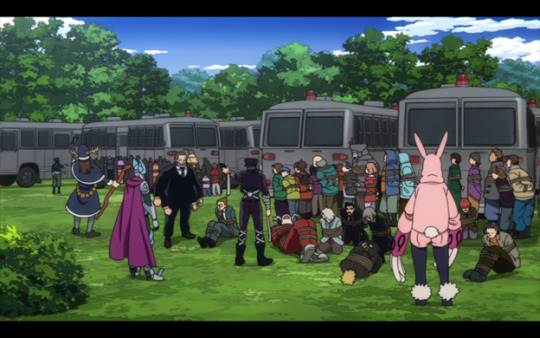
I am agog at how huge and accessible and openable those windows look. Why on earth would you use vehicles like that for prisoner transport?) Are they just packing dangerous terrorists back onto the same buses the Heroes used to get up here, or what?
Comparing that to the equivalent shot in the manga, they didn’t get any of these people right. (Excluding the Heroes, who get relatively faithful if slightly less detailed renditions. Because of course they do.)
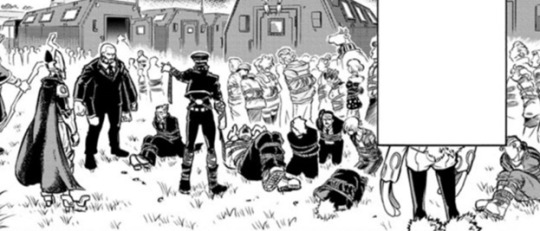
Look at the windows on these transports and laugh with me about how ridiculous the ones in the anime are in comparison. Also, I notice that while the anime got Tartarus Hat: The Capture Tape Hero's look right, they did fail to notice that the restraints dangling loose from his wrists are the same as those the PLF captives are bound with.
Not every person on the ground here is tentatively identifiable as a ranked advisor—only, you know, five out of seven of them, the entire middle group. The two on the back right are really obviously Galvanize and Piercings Dude (Compress’s #1 and Dabi’s #3), and given the visual similarities and the grouping, I’m pretty confident the others are Fray (Toga’s #3), Red (Skeptic’s #1) and Band Jacket Guy (Compress’s #2).
Yet even given the anime’s sloppy, ugly coloring decisions for the advisors they did show, they didn’t even accidentally get any of these right. Band Jacket Guy and Fray are both dark-haired in the anime, while Red’s honey blonde and Piercings Dude is silver-haired with a striped coat jacket. I would almost venture to guess that the anime intended the dude they gave the handlebar mustache to above (Galvanize in the manga, as apparent by his forelock and forehead scar) to be Sanctum, save that they didn’t those colors right, either! They have Sanctum in white in the opening attack scene and in blue in Twice’s imagine spot.
Just an impressively thorough failure to realize the manga’s intention.
One thing you didn’t mention that I wondered about was Scarecrow’s first scene of note, so I also looked that up—I wanted to see if he had a voice actor yet, given how important his voice would turn out to be!
Lo and behind, I find that the anime—while at least including Scarecrow, absolutely not guaranteed, as the above dissection shows!—gave what I had always assumed to be his dialogue to Re-Destro instead. Which, I guess, looking at the manga again, could be the intention? But I don’t really read it that way.

It’s certainly flowery enough to be Re-Destro! He definitely talks like that! But, as we later find out, Scarecrow absolutely talks like that too. And here, looking at the paneling and the way the talk bubbles fall within it, we can see that Re-Destro’s obvious dialogue (“What did you pesky Heroes do to our savior and liberator?!”) breaks out of the panel binding, overlapping into the scene change to Gigantomachia’s rampage.
That’s what I would expect to be the case if the next line (“After Gigantomachia, Liberation warriors! Our revolution is at hand!”) was also meant to be his, ringing out so loudly over the battlefield that even out in the forest, it’s still audible above the sounds of pitched, widespread conflict.
Instead of being overlaid across the panel borders like the others, though, it’s fully contained within the panels, visually implying that the line is being delivered by someone within that same scene/panel, for which the most obvious candidate is the guy prominently foregrounded in it. I suppose the counter-argument is that there aren’t any obvious tails to the talk bubble that would link it to him, as with the bubbles in final panel with Kamui Woods and Midnight, but then, Re-Destro’s shouting doesn’t have any tails, either!
Overall, I guess it’s a valid read, but I frankly just don’t like it as much as I do the dialogue serving as an early indicator of Scarecrow’s personality. Also, while it surely pleases me to contemplate that Re-Destro loves Shigaraki so much that he’d order a sizeable chunk of his own army to abandon him in favor of going to his savior and liberator, I have to think that if he did give that order, considerably more than a piddling 132 out of 17,000 people at the Villa would have successfully prioritized escape!
Sorry for taking so long with this one, shockersalvage! My plan was to respond to it when I got back to PLF Spotting posts, but I just don’t think I can be arsed with those at this point. I kind of unreasonably hate the stupid puce-colored arm the anime saddled Shigaraki with for some godforsaken reason, and I’ve not yet forgiven the show for giving Re-Destro an anime-original scene but fucking it up by having him identify Destro Classic as his literal father. Also, while the anime transparently doesn’t care about the PLF, it’s only emulating its source material in that regard, so it's hard to muster up too much righteous indignation on the manga's behalf.
Regardless, thank you as always for the ask and your patience! Please do feel free to report back in with any further PLF Erasure Crimes the anime commits; I'm not expecting to pay it much attention at this point save probably ducking in to watch Scarecrow's wonderful rooftop speech at the hospital riot.
(You know, assuming they let him keep it.)
#bnha#plf advisors#yotsubashi rikiya#re-destro#the anime continues to be Bad#news at eleven#shockersalvage#stillness answers
10 notes
·
View notes
Note
thoughts on the new chapter? you said before spinneraki is a pillar in the story and i think this chapter continues to be evidence of that

For these two anons who asked for them, have some Chapter Thoughts, 411-version. Herein can be found two big chunks of musing about, respectively, OFA & Shigaraki and the Shigaraki+Deku+Spinner confluence, as well as the usual handful of stray thoughts.
(I'm also going to throw in a few last minute thoughts about plot events between here and the last chapter I had a post on, Chapter 392. They'll be off-the-cuff and not comprehensive; feel free to send an ask if there's anything specific you're curious about, though I can't at this time promise e.g. the twelve thousand word essay on why the AFO vs. All Might fight sucks rocks.)
Chapter Thoughts — Chapter 411: History's Greatest Villain
OFA Vestiges vs. Shigaraki Tomura
Shinomori remains my favorite OFA bearer by a large margin; I enjoy how his quirk allows him to be the one bearer with his act together this chapter. I also like that him being the vestige that actively chooses to sacrifice “himself” for the good of the rest of One For All makes a nice bookend with my preferred headcanon that he was the bearer who had the power forced on him against his will.
That said, it is a bit ironic that Danger Sense surely had to rank right up near the top of OFA quirks that it’s most dangerous for Deku to lose to Shigaraki! Like, throw Shigaraki En or something; Smoke Screen’s not going to let Shigaraki do anything Deku can’t counter with Danger Sense! Sacrifice Nana; Deku and Shigaraki both already have ways to keep aloft enough.[1] So I appreciate both the display of Shinomori’s instinctive heroism and the dramatic choice to deprive Deku of such a key component of his defense, after god knows how many chapters of dramatic choices I pretty much hate across the board.
1: That said, it does look like the person Shinomori shoved most directly out of the way was Banjo, his own successor, which speaks to their bond and also spares Deku losing a crucial quirk, as Black Whip has been his main way to exert any control at all over the battle with Shigaraki and is also helping keep his arms braced. As someone who wanted those humerus consequences after the first war, I say, “Go, Shigaraki, go! Get the Sixth next!”
My god, the rest of them are such a mess this chapter. Very funny, actually. Shaking my head at them in there talking about how to “bring down” Shigaraki, who they know good and well Deku wants to help. “Our entire reason for still existing!” No, Bro Bro, you existed solely to take down All For One, which Bakugou et. al. have neatly taken care of for you. The only other purpose ever given to you was to save people, but I guess you’ve already forgotten that.
Seriously, I love the discord this chapter, the panic and fear, particularly from the youthful En—watching that unified will crumble in the face of Shigaraki’s hatred is a wonderful balm to all the times I had to suffer through seeing commenters elsewhere on the internet blithely taking it for granted that One For All could never be stolen just because All Might said it was so, laughing it off when Ujiko promised Shigaraki otherwise. My villain fan agenda aside, though, it’s also a rare highlight for Deku that I like, which I’ll circle back to.
Regarding Shigaraki with Danger Sense, I know there was some discussion of whether he’d be able to fully utilize it against Deku when Deku wants to “save” him. As giving Deku that out would have been the story yet again undermining the villains’ fairly won victories (and as Danger Sense has been so wildly inconsistently written that Horikoshi could have gotten away with practically anything), I’m pleased to see it’s working as intended! That said, you probably could have some interesting discussion of exactly whose “intent” Danger Sense is picking up on. Deku may want to help Shigaraki, but e.g. Banjo, Bruce and Kudou certainly don’t seem to want that! Given how explicitly Kudou was synonymizing quirks and wills back in Chapter 369,[2] and particularly given that Shigaraki can perceive the vestiges now, it wouldn’t surprise me if their wills are bleeding over into Deku’s usage of their quirks.
2: I.e. the “gaslighting the readership about the historical usage of meta-ability terminology” chapter.
I do wonder if this is set-up for Shinomori—and potentially other quirks as well, including any more OFA vestiges Shigaraki manages to snag!—giving us a tired retread of the “quirk vestiges mount a resistance against their unrightful bearer at a critical juncture” moments we saw with AFO, but I suppose that’d be what Shigaraki gets for trying to steal bits of OFA after saying previously that he didn’t care about it. (Sigh.)
Deku, Spinner, and Shigaraki Tomura's "Personhood"
I appreciate Deku pushing back against Shigaraki’s dehumanization, though it does not escape me that he directs that pushback to Shigaraki himself, not any of the voices inside Deku’s head calling Shigaraki calamity and ruin incarnate, and certainly not any actual humans on his side in the real world. It smacks of the same pattern heroes always fall into of leaping to castigate villains for things they tacitly ignore in their own allies. Still, it is at least spoken aloud, and to Shigaraki’s face, which is a pleasant change.
I swear to Christ, if after all this time Spinner becomes a bridge between Shigaraki and Deku after all, I am going to be so damn smug. Albeit in different contexts, I called that years ago, and lo and behold, here we have Shigaraki, accused of having no friends, self-dehumanized, and depersonalized by Deku’s allies, immediately refute the point by bringing up his best friend of his own volition, tying his destruction to someone outside of himself.
While Deku hasn’t connected the dots on-page yet, he certainly can’t have missed it, though it remains to be seen how much about Spinner Deku actually knows/remembers from their encounter at the training camp—that encounter long being an important part of my reasoning that Spinner could, via his and Deku’s shared respect for Stain and desire to help Shigaraki, find some common ground.
Moreover, we get Deku flashing to Uraraka—as well he should! Since Uraraka is the only one who managed to unearth some empathy for her designated villain foil without a familial or fated connection to them, she deserves to feature prominently in Deku’s attempts to connect with his own opposite number.
I do wonder if we will yet get a flashback to the mall scene. Honestly, Deku could have kickstarted his connection to Shigaraki all the way back then, when Shigaraki functionally laid his damage out in front of Deku like fine china, only for Deku to grab the first excuse anyone gave him to write it off and forget about it. The story could probably get away with not reminding the readers of that—after all, Shigaraki hasn’t really changed his grievance since then, just expanded his invocation of blame! His monologue at Jakku is just a refined version of what he said at the mall encounter, so the only reason to flash back to the less developed take is to have Deku vocalize that he could (and should!) have been wondering about Shigaraki as “a person, too” this whole time, instead of only coming to do so after their mindscape encounter.
Acknowledging the gaps in Saint Deku’s Miraculous Saving Instincts would go a long, long way towards softening me on the narrative BNHA’s been trying to sell me on its main character.
Anyway, three cheers for Spinaraki; they never fuckin’ lose, do they? It’s particularly gratifying in light of the way people on Twitter were speedrunning the shift from dismissing Spinner as unimportant to criticizing him as “toxic” as it became more and more clear that saving Shigaraki was going to be more complicated than just dealing with AFO. People really thought that if Deku could just lay all the blame for Shigaraki’s anger at AFO’s feet, then he could just wipe it away, eradicating “Shigaraki Tomura”—who was never really a person anyway, just fifteen years of grooming and coping mechanisms—and leaving behind only sweet, innocent, undemanding Shimura Tenko.
But if Shigaraki was carrying anger for others, blame for wrongs that couldn’t be attributed to AFO, suddenly that narrative got messier. Suddenly the League needed to be Bad For Each Other, needed to be separated for their own good, redeemed by the grace of their designated student foils—and nowhere was that trickier than with Spinner, who didn’t have one, and whose every flashback post-war made it clearer and clearer that he had a relationship with Shigaraki that went beyond the League’s stated purpose as an alliance of Villains to bring down Hero Society.
The tidier version of the story would still be salvageable if Shigaraki didn’t really care about Spinner more than anyone else in the League, if Spinner’s devotion were one-sided, if Shigaraki didn’t determine to share Spinner’s grievance. If Spinner’s problems aren’t Shigaraki’s problems too, then Deku doesn’t have to address them. And but so, the mad scramble to invalidate the connection by any means possible.
But then here comes Shigaraki not just mentioning Spinner, but mentioning something Spinner wanted that Spinner never even told him about on the page, meaning either Shigaraki was paying close enough attention to Spinner to simply intuit it, or he and Spinner had an off-page conversation about Deika where Spinner in all his insecurity was able to admit to Shigaraki that he thought his horizon was beautiful. And not only does Shigaraki remember this, he dedicates his destruction of Mount Fuji to Spinner and the horizon.
Not so one-sided after all, is it?
That all said, of course it’s also worth asking if Spinner actually wants the horizon anymore. Judging by his tormented inner reflections when striving to reach Kurogiri, that doesn’t really seem to be the case. At the end of Spinner’s strength, what he truly remembers and treasures is the time he and Shigaraki spent just dicking around talking about video games—just being friends. Spinner wants Shigaraki to get what he wants—but if they’re both just crediting That Beautiful Horizon to each other without realizing it’s not really about what they themselves want anymore, where does that leave them?
One suspects that was one function of the possession plot—keeping them from talking to each other freely and being able to figure that out themselves. As it is, with the possession plot seemingly off the table, at least for now, that brings us back to Deku and his resolution to reach the humanity in Shigaraki Tomura—a humanity that Shigaraki just helpfully signposted by referencing his friend Spinner.
So how long until we cut away to find out where the Rooftop Trio and Spinner have gotten off to?
Stray Thoughts
Re: Mount Fuji, Horikoshi’s grasp of travel times remains as totally unhinged as ever. Someone who can make rudimentary animations needs to use that battle map volume extra to demonstrate exactly the distances that would have to traversed by All For One, U.A., All Might and especially Lady Nagant and her bullets in this final arc for them to keep arriving where the story needs them to be.
I see the artistic indication is very much that Shigaraki can just spread Decay wherever he walks now. That’s both wonderfully evocative for the embodied destructive divine impulse he’s nominally become and also a bit amusing, because if you can unlock a touch-based quirk to spread through your feet, maybe Overhaul’s not out of luck just yet after all. XD
Good riddance to the mask! As others have pointed out, it’s modelled on All Might’s smile, and is therefore the last thing Deku should be wearing right now, given that Shigaraki has specifically expressed, to Deku’s face, that he hates All Might’s fucking smile, “As if there’s no one he can’t save!” Hope Shigaraki gets that damn cape next, such as is left of it.
Events Up To Now (Chapters 393 - 410)
The resolution of the Ochaco vs. Toga fight is very solid emotionally, though hampered by yet more nerfing of Toga's power set to make sure she can't do all the damage she should logically be capable of doing, as well as a lot of incredibly tiresome shoehorning in of mentions of Deku just to make sure everyone gets how Not Homo it is for Ochaco to tell Toga she's the cutest girl in the whole world. But I love that Toga remains unrepentant and faithful to Shigaraki to the end. I will turn a lot less nice about this if Toga turns out to have actually died here, however.
(She should have gotten to stab fucking Hawks.)
The All Might vs. AFO fight sucks rocks. The mech suit makes a nonsense of All Might's primary arc post-Kamino, it's flatly irreconcileable with his characterization throughout the Edgy Deku arc, it leans on a bond with the 1-A students that he has entirely failed to earn, and it parades their identies and power sets out in front of the world with absolutely zero indication that he ever asked them if they were okay with that. As an answer to the "quirkless hero" question it is purest sophistry, laughably detached from reality.
The world's reaction to the All Might vs. AFO fight sucks rocks. The return of Wishing Energy is the obvious point of note, but I prefer to focus on how patently ridiculous it is that across the multitudinous barriers of age, language, culture, politics, national attitude, wealth level, and views on heroism, everyone in the world who watches the battle and gets into it enough to really pay attention is magically able to intuit that the man in the black military hardware suit injecting acid into the underclothed twelve-year-old is the "Hero."
Kunieda is a delight and he and Aoyama should have had history going back to AFO's sway over the family.
Shigaraki is great when he's getting actual attention, but as part and parcel of the AFO vs. All Might fight sucking on such intergalactic levels, it made Shigaraki awful, too, reducing him to generic last boss counting-his-evil-chickens-before-they're-hatched gloating. Praying we see no more of that going forward.
It is extremely headshaking in retrospect that the Heroes actively acknowledged during the planning process for all this that they would prefer to engage with the AFO persona in Shigaraki than Shigaraki himself, the Heroes then find out during the battle that AFO is trying to get to Shigaraki with the specific aim of reawakening said persona, and yet the Jakku team, All Might and Bakugou still blow interminable fucking chapters on preventing AFO from doing the exact thing that would get them back the persona they explicitly stated it would be preferable to deal with.
Edgeshot continues to be Just The Worst, not even having the decency to wait until the endgame to confirm what I predicted back when the nonsense about repairing Bakugou's heart first came up: that, "You won't be able to come back from this," is a bald-faced lie intended to ratchet up tension, one that would be rolled back the instant the danger was past and Bakugou could be gotten to a proper hospital room.
AFO's backstory is the laziest of lazy dreck. The new information soundly deprives Yoichi of the marginal amounts of agency he had previously managed to suggest he exercised, conflicts with what's been previously implied about the brothers' personal history, fails to reconcile the child AFO with the man we met in Deku's dream prior to Joint Training, and reduces all of the interpersonal drama between AFO, Yoichi and Kudou into nothing more than a reason for Bakugou to inspire fear and distress in BabyFO. (See @robotlesbianjavert's post and Nal's tags on it here, and @codenamesazanka's post here.)
Omni-Factor Unleash is a retread of Kamino AND Overhaul's minion forms AND Akira-fied Shigaraki. You guys, I think maybe Horikoshi is Bad At Coming Up With Final Boss Attacks.
#bnha#chapter thoughts#bnha 411#and some other chapters as well#amazing how much more tolerable these chapters are when shigaraki's properly in the driver's seat#based on prior performance i don't expect it to last#but it's nice to have for now#and the spinaraki vindication is indeed sweet#my writing#stillness answers
21 notes
·
View notes
Text
Favorite Characters of 2023
Saw this meme template by @limayde and had to drop anything more productive because I Love Character Memes. I tried to focus on characters who particularly signified 2023 in fandom for me, not necessarily just my favorites in any given fandom, and certainly not my favorites of all time! So consider it a reasonable representation of what I read/was reading/was still thinking about last year.
(I'm also relatively sure I could fill this out entirely with BNHA characters, but if I were to do that, it would be with the goal of representing how much I was thinking about said characters in terms of Fix-It Fic(s) Brainstorming, rather than simply how much I like them. Yoichi would be prominent in the former and not present at all in the latter, for example.)
Anyway, after much painstaking cropping, here it is!
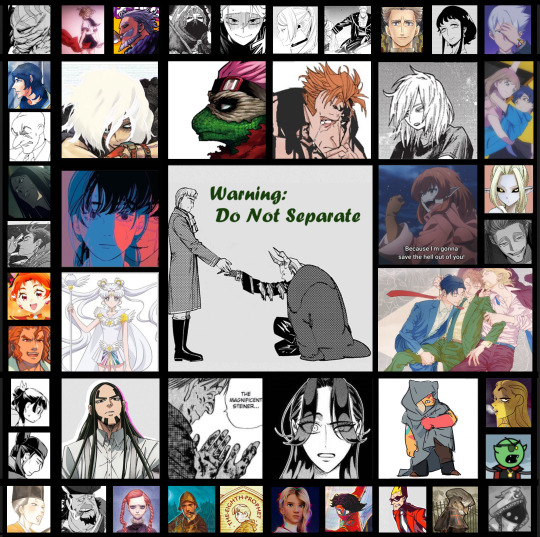
(A full list of who all these people are and a blurb apiece of my thoughts on them, as well as the meme template, can be found beneath the cut!)
Most Favorite Blorbo(s) of 2023
Lord Glück and Macht of El Dorado (Sousou no Frieren) – Macht's was the arc that turned me around on Frieren's treatment of demons—he’s so interesting, and so tragic, totally set in his ways while also yearning to change them. Glück, meanwhile, is so devoted to his word, blunt in his assessment of Macht’s character but wholly sincere about trying to give him the knowledge and environment he needs to change. My BF asked me for the spoiler-free version of what I liked about them, and the best I can sum it up as is, “A mutual acceptance despite the parts of each other they can’t understand,” and, “They’ve made each other promises that go all the way to end, to the goddamn end.” Thirty years of that! I am once again begging on my hands and knees for Frieren to get a second season, and also, if the universe really loves me, to end the first season with a tease for the Golden City.[1]
(I cheated a bit here; the central square is intended for a single supreme fave, not center-mounting one's OTP. I am, however, entirely incapable of picking one of those two above the other. Also, putting them both there does bring the character count to a nice even 50.}
1: A second tease. There’s actually been one already, a reference to Macht’s enchanted jewelry, squirreled away in some on-screen text—one of the anime’s many additions to the background detail compared to the manga.
12 Characters vs. 12 Months In A Year. Coincidence? Probably!
(Starting at the top left corner and moving clockwise.)
Shigaraki Tomura (BNHA) – 2023 was the year Shigaraki Tomura got his groove back, thank heavens. While he didn’t get much material in which to speak his own mind—really just Chapters 379 and 411, a full year apart (the latter didn’t officially come out until just a few days ago; we just got the leaks a week early). We’ll see how he holds up going forward, but even those few scenes effortlessly demonstrate just how profound a waste of time handing AFO the reins to the end game was. Here’s to not letting Heroes off the hook in the new year!
Iguchi Shuuichi/Spinner (BNHA) – Spent a lot of 2023 worrying about this guy. Still am worried about this guy. But him turning the tides of the war at the end of 2022 shifted the whole course of the battle, and new we’ve got Shigaraki invoking The Horizon to finally give us incontrovertible evidence that Shigaraki and Spinner have talked about more than just video games! 2024 is shaping up Spinaraki!
Yotsubashi Rikiya/Re-Destro (BNHA) – I provide fanart for this man because, of course, he was in the actual canon not at all last year, absent a single flashback panel from Hose Face, not at all making up for what a caricature that character was otherwise. All the good Re-Destro content I was getting last year was thanks to @nickfoo’s wonderful, wonderful fanart of him. Thanks for continuing to give this guy love, foo! (full art here)
Geten (BNHA) – Himura backstory reveal! And that revelation accounted for the only fanfic I posted last year at all, as well as being super satisfying in terms of largely clearing Todoroki Enji of the responsibility for the heteromorphobic microaggressions perpetrated by certain of his children, as well as giving us some more hints about Geten and Re-Destro’s relationship. Exquisite. (Now just let him have something to say that isn’t mostly there to Contextualize Dabi.)
Vamirio/Anne from Management (Helck) – I reread Helck last year in celebration of its anime, and just to reiterate this again, Vamirio and her determination lead her to make firm stands and fiery declarations about her combat role and priorities that Deku has never even fuckin’ thought about. Vamirio a best; vote Vamirio for Head of Management.
Samuel Murphy +Hal and Nobu (Canis: The Speaker) – Sam’s my favorite of another inseparable trio, probably because, at least as an adult, he’s the most vulnerable—not simply because he lacks the firearms or goons that his partners’ positions allow them to call to hand, but also because of his struggles with insomnia. Whip-smart, observant, and well-spoken, and I always have had a preference for the smart ones.
Jasper (Steven Universe) – I started reading @faelapis’s post-canon Jasper exploration fic Something Better last year and absolutely fell in love with it. It reminded me all over again how much I love Jasper, and how much I wanted a story that gave her all the time she needed to change.
Somei Yoshino (Yakuza Fiancée) – Last year saw the anime announcement and Yoshino’s totally amazing bathtub fight with Azami, which I guess there are cowards out there who didn’t like? RIP to them but I’m different, I guess! I’ll watch Yoshino break her terrible suitors’ fingers any time!
Wolfgang Grimmer (Monster) – Reread the back half of Monster last year solely because I love Grimmer and wanted to read his material again. A perennial favorite, manga and character alike. I love a man held together with scotch tape, stitches and good intentions.
Boutarou the Pirate (Golden Kamuy) – Probably not my actual favorite character in the series, but I finally got to see him in anime form last year after a maddening wait thanks to the delay in 2022. Shiraishi’s best ship and a feral merman (look at the way he uses his hair and tell me I'm wrong) that someone unaccountably let walk around on dry land. A+ character.
Sailor Cosmos (Sailor Moon) – Speaking of characters with a huge wait on seeing them in the anime..! God, I’ve wanted anime Sailor Cosmos since high school, and I’m thrilled to finally get her (and the merch that would accompany her).
Mitaka Asa (Chainsaw Man) – I read the first half of Chainsaw Man a while back, largely on the basis of @robotlesbianjavert’s enthusiasm, and while I enjoyed it well enough, particularly Denji’s assorted travails, I never got super invested in it because, not having to wait week to week for releases, there was never really enough time to get attached to most characters before they got unceremoniously offed. Whether it’s the week-to-week wait or just that I like Asa as a character more, she’s really done the job of getting me interested in the series. I love this loser failgirl and I want only the best for her; while I doubt that’s what she’ll get, at least I can watch her torture logic to make sick weapons and have affecting scenes about her own crippling inadequacy issues in the meantime.
36 Others
(As before, starting on the top left and moving clockwise through the BNHA Zone.)
Scarecrow/Spinner’s Number 2 (BNHA) – Scarecrow’s big speechifying moments would have been back in autumn of 2022, but I still loved him more than enough in 2023 for him to make this grid. He was reduced to a shallow caricature and still had to get knocked off a roof because no one could actually out-argue him, and through all of that unendurable authorial laziness, his potential still shines through for me. Stan the MLA, MLA 5Evah.
Toga Himiko (BNHA) – The only Villain whose Hero foil plotline is working for me on any level, though a lot is hanging on whether or not she, y’know, lives. She definitely should have gotten to stab the bejeezus out of Hawks, and Ochaco should definitely go on the run with her once Apple Cheeks realizes that the HeroAca justice system could not possibly be relied upon to do anything other than throw Toga in a hole for a few years before executing her.
Gentle Criminal (BNHA) – The only redeemed villain whose regard for Deku functions at all thematically. Lady N’s return is hogswash on multiple levels, but I will defend Gentle’s without reservation.
Kunieda + Aoyama Yuuga (BNHA) – Consider these two to be a stand-in for all the thinking I did last year about Fix-It Fic scenarios for this whole final arc. For example, Kunieda in the canon speaks far too knowledgeably both about and to Aoyama for them to be total strangers, so why not plant some seeds for their confrontations earlier? I ask the reader to consider this:
In a version of the Edgy Deku arc that allowed the rest of 1-A to get out into the world to help out with relocation efforts, they one day come across a scene of dread: a neighborhood full of corpses and Kunieda’s flowers. Aoyama has a noticeably shaken reaction, which he plays off as just horror to his similarly horrified classmates, but the truth is that he’s got prior history with Kunieda—AFO didn’t plop corpses in front of his parents to intimidate them (because that’s ham-handed and silly), but bodies were still involved. They’d turn up buried in the family's fancy gardens sometimes, always heralded by those vivid red-black flowers…
Frieren (Sousou no Frieren) – I was relatively neutral on the title character until the anime came out and I had to suffer through The Discourse about her attitude towards demons (arguments on both sides tending to be poorly considered and ignorant, both of canonical details and real-world relevance). That made me a bit more defensive of her, but even setting my contrarianism aside, I was also very pleased with how she navigated the manga’s most recent arc.[2] She’s maybe the first character I can think of who I have actively wanted to write Asexual Representation fic for, if only because my answer to, “Does she Romantically Love Himmel?” is much more complex than just saying, “No, she only saw him as a friend,” or, “Yes, and now she’s going to be sad about her Tragically Lost Love for the rest of her life and we need to write all the fix-it fics about that.”
2: She wants to go home! Her feelings for Himmel, whatever they are, are of less importance to her than going home! Despite everything we know about how she perceives time, she still values her “now” more than her lost “then”! My gloating aside, though, I was far more affected by the sword scene than I was the wedding attire or the near kiss. Being trapped in a wedding illusion? Trite, overplayed. Being trapped in a wedding illusion yet still being able to wrap your hands around your partner’s arm and faithfully guide them into drawing the sword neither of you can perceive? Now that’s intimacy!
Heiter (Sousou no Frieren) – While I had little overall use for the aforementioned most recent arc of Frieren, I did very much enjoy my favorite member of the Hero Party getting a moment to demonstrate what being The Priest Of The Party That Defeated The Demon King actually means in practice. Grausam being unable to put him down with an illusion? Being the only one who could defend his downed companions? The sheer level of trust he has in Himmel? A little bit of vulnerability where he’s bare seconds away from getting gibbed by Grausam? Heiter is the member of the party that we get the least amount of in on: Sein didn’t stay with the party long enough to serve as a point of comparison, and despite Heiter raising Fern, she didn’t assume his role in the new group, like Stark did Eisen’s, nor do her reminiscences about him get anywhere near the amount of screentime that Frieren’s do of Himmel. So for real, you guys, Chapter 118 was so good.
Edward (Shadows House) – *bangs fists on table* WORST BOY WORST BOY WORST BOY!! Anime Edward is pants, but Manga Edward is where it’s at, always keeping Kate scrambling, always coming out on top of his maneuverings against his peer group rivals, just flappable enough that his victories doesn’t look effortless, and engaging enough that his smugness feels earned rather than intended to turn the reader against him. I have no idea how the story is going to deal with the adult shadows, who are after all still just as brainwashed and wronged by Grandfather’s workings as the kids are! If anything, they’re worse off, having already been manipulated into losing the “faces” they must once have loved dearly. Thus, while Kate and her allies certainly approach the conflict with a very Us vs. Them, Adults=The Enemy mentality, the screentime Edward’s own affairs get, fully independent of how they intersect with Kate’s, along with an avowed desire to improve the House that parallels Kate’s, make me hopeful that the authors have something a little more nuanced in mind than, “Free the current victims by wiping out all the previous ones.”
Melinda Desmond (Spy x Family) – The main cast are all perfectly fine, but Melinda is interesting. Super curious to find out more about the Desmond family dynamics, and I love Melinda bouncing around with Yor. (I swear, though, judging by the collective response to the most recent chapter, the fandom is going to turn me into a Donovan Apologist yet. Only one member of that family has visible scars suggesting brain surgery, folks!!)
Anti/Knight/Gridknight (Gridman Universe) – Always my favorite single character from both Gridman and Dynazenon, and he was characteristically great in the movie as well. His scene with Akane at the end was only my second favorite beat because, while it’s wonderful emotionally cathartic (more fanservice like this, please!), it’s also kind of muddled thanks to the idea of Gridman!Anti and Dynazenon!Knight being two separate entities. Churlish to hold that against it, though, when it's so heartfelt.
Minami Yume + Asanaka Yomogi (Gridman Universe) – Such a great pairing in their own show—I once saw someone call them forced, which has always struck me as just being too high on Bashing The Hets to see that Yomogi and Yume have a great arc towards getting together, actually. Seeing them be unabashedly together and happy about it in the film was 100% delightful and deserved. Yume swooping down out of the sky on Dynarex to scoop up her wifeguy boyfriend is my actual favorite beat in the movie.
Hyura (Helck) – Firstly, the dry humor around Hyura is fantastic. (“Something like an arm grows back simply enough. That’s just common sense.” “It doesn’t, right?” “It does not.”) Secondly, she’s the biggest badass in the secondary cast. Thirdly, she and Edil have the designated rival ship dynamic (incredibly rare to see across gender lines in shounen manga), and Hyura holds her own all the way to the end. Hyura is great.
Mikaros (Helck) – “Yes, we may have lost some assets and I personally shattered the mind of one of our strongest soldiers, removing him from the playing field. But the important thing is that I personally overcame my trauma, so overall it’s a win.” What a slimeball. What a total heap. And what an excellent example of the end-stage stakes driving the title character's choice in the epilogue! I love Mikaros unreservedly.
Harold Aldo Hughes and Iwaki Tadanobu + Sam (Canis: The Speaker) – Transformation, reinvention, the fierceness of devotion and the ruthlessness of rebirth—I don’t love them quite as much as I do Sam, but they’re also both great.
Hera (Lore Olympus) – Lore Olympus is one of those series I read more because it’s interesting enough while also being blisteringly gorgeous than because I’m deeply invested in the characters, but the plotline about Hera and Kronos really has pulled me all the way into active, character-specific interest. Great, tense, painful stuff. Can’t wait to see where she goes following recent events.
Redcloak (Order of the Stick) – His last really insightful and heartwrenching scene was in the year before last—that fantastic exchange with Oona!—but for as long as I’m reading OOTS, Redcloak is going to be a favorite. God, the Law Elemental summoning is so funny.
Hyness (Kirby franchise) – This one’s entirely on my sis-in-law—like another character further down the list, I am not remotely “in” the Kirby fandom. But what can I say—tell me about a warped cult leader who started in a bad place and only got worse who still managed to get saved by the Hero taking a leap of faith that paid off, and tell me the fandom calls him a horrible abuser? Sorry, but I Have No Choice But To Stan. (full art here)
Lafcadio Boone (The Sexy Brutale) – Replayed this again last year, and it’s still great. In a sense, despite its sizeable named cast, it really only has the one character, and his story is such that I want to make every single person on tumblr that gets hyperbolic about the forgiveness and redemption of fictional wrongdoers play this game. “Time to move on, old man,” indeed.
Sissel (Ghost Trick) – Finally got the remaster of this and replayed it, and it’s also still great. Knowing The Spoilers about Sissel seriously make replays such a scream, but also man is this game really sitting on some completely over-the-top darkness not at all far beneath its candy apple red and Matrix-text green surface.
Pavitr Prabhakar/Spider-Man India (Across the Spider-Verse) – Strictly in terms of character writing, he’s very fun, but I don’t think he’s as strong as Spider-Punk or Miguel O'Hara, but on the other hand, he’s so much fun, especially to simply watch in motion. Most of the rest of the leads, however varied their artstyles might be, still feel like they move in basically the same ways, just with varying levels of grace vs. power, intent vs. controlled collapse, but because of the way Pavitr uses his thread, he moves completely differently, and it’s just a ton of fun to watch. The first character I went hunting for fanart of when I got out of the movie theater.
Gwen Stacy/Spider-Woman (Across the Spider-Verse) – I have outstanding affection for Spider-Gwen from reading her comics back when, but that opening Vulture fight, the fantastic look of her dimension, and all the trans signaling kept her right at the top, too.
Brutha (Discworld: Small Gods) – @codenamesazanka read this and a few of the Watch books last year, prompting me to do some rereads as well, and Brutha and Small Gods remain very dear to me. I only wish more artists would draw versions of him that remotely resemble “fat, simple-looking young man from a desert country in fantasy!expy!Middle East” rather than “suspiciously trim and Benedictine.”
Sam Vimes (Discworld series) – Ditto on Nal’s read above, but also chatted with foo a lot about this guy, and he’s been my favorite single character in the series since high school. It takes very little to prompt me to reread his books generally, but last year was the first time I’ve had it in me to reread Snuff, as it was previously a little too tied up in my feelings about the last few books prior to Pratchett’s death. Regardless of anything else, though, Snuff is the book for Sam/Sybil.
Mina Murray (#DRCL: Midnight Children) – Discovered this lush chonk of horror phantasmagoria last year and I’m kind of in love with it. Its take on Mina anchors it well—she’s smart and fiery but up against ingrained sexism and classism in her setting, and not too Anachronistic Grrl Power to not be hurt by that sometimes; she’s stubborn, but vulnerable to the supernatural horrors in the way any child would be. An unreliable but intriguing and sympathetic narrator.
Capone Bege (One Piece) – The other character I got onto largely without getting into the series he hails from, nickfoo—whose art I again use to illustrate—does great work with this guy, a once-jovial monster shocked back from that moral brink by marriage and fatherhood. Still gets a bit Into It at work, but tries not to bring it home, at least as much as that can be avoided when carrying both family and crew around in the same heart/sub-dimensional space. (Also, foo’s version of Bege is great, but her rendition of Chiffon is—speaking as someone who doesn’t read the series and can only gauge by image search or skimming the wiki—borderline miraculous, accurate to Oda’s lively caricature design, but so much more sensitive, expressive and human.)
Prince Kazu/Lady Chikako (Ooku: The Inner Chambers) – On the occasion of the Netflix anime, I finally tracked down and finished Ooku last year, and when I tell you that I laughed more and harder in the final arc than I did through the entire rest of the series combined… The Kyoto cast members are a big part of why,[3] and none more delightful than the stuffy, prideful, possessive, and deeply impetuous Chikako, one of the most singularly human characters in the whole 19-volume melodrama.
3: Catty ex-male prostitute turned head of the Inner Chambers Takiyama is the other part of this equation, by the way.
Gao Shun (The Apothecary Diaries) – Long-suffering stoics are my absolute favorite type, and that holds true even though Gao Shun's stoicism has been largely a humorous beat thus far. I want this guy to get more attention, but until then, I will continue to enjoy his weary exasperation every time he has to deal with Mao Mao’s eccentricities/Jinshi’s enthusiasm about same.
Mao Mao (The Apothecary Diaries) – Best female character of the season, for sure, but I’ve been reading one of the manga for a while now, and she’s a regular delight. Eccentric and ruthless by turns, painfully aware of the limitations of her position and yet wholly willing to make her own decisions and exert her own agency within those limitations without ever concerning herself with whether she should ask permission from or report to someone above her rank. Mao Mao’s mercy takes the form of knowing when to speak and when to demure, and every time I see some stuck-in-their-own-ethical-framework commenter complain about her moral compass, I appreciate it harder.
Accustomizer Stud/Tiffany (Angelic Acceptor Alouette) – Enthusiastically resourceful teenage girl who would probably be super into transhumanism if she hadn’t fallen in with angels (sic) instead, transforming into the gloriously nonbinary pile of muscles and amazing hair that is Accustomizer Stud, Tiffany’s ultimate expression of her inner self. Stud is magnanimous, gracious, and well-spoken, and they are also VERY LOUD AND FIGHTY. My absolute favorite character in a game wall-to-wall with great characters.
Yuunagi Tsubasa/Cure Wing (Hirogaru Sky PreCure) – The first Official Boy Cure with absolutely no provisos or qualifications or ways to wiggle out of it, and the show gets him just right by playing him basically completely straight. Has a costume no one would look twice at in a magical girl line-up, wastes no time on masculine embarrassment at his frills, with the only nod he/the show make towards his gender at all being to frame his role as being a knight to a princess, rather than simply a guardian to one, but it’s not really what he’s about. His actual character is driven by knowledge, studiousness, and a desire to overcome the limitations placed on him by being a human/pudgy flightless bird fairy.
Kei Miyama (Go With the Clouds, North By Northwest) – Something of a stand-in for his series generally, which I read the two most recent volumes of last year and fell in love with all over again—particularly the most recent one, which switches deftly between depictions of shattering, world-hollowing grief and the beguiling intimacy of the rhythms of life and nature. But my love for the manga itself aside, Kei’s a great protagonist, full of little contradictions and snags that make him feel much more fleshed out and grounded than your average animanga male lead, even as he’s running around doing very Animanga Male Lead Things, like solving mysteries by using his Strange Power to get information a normal person could not.
Lord El-Melloi II/Waver Velvet (Fate franchise) – Waver is possibly my favorite character of all time in any medium, so it takes very little to rekindle the love. In last year's case, it took the Fate/strange Fake special! Love to see my boy continue to wrest more narrative space for himself than he was originally allotted by virtue of being a run-away audience favorite of the Fate/Zero anime!
Ivan (Giant Robo: The Day the Earth Stood Still) – Got the remastered Blu-ray last year as a gift, and guess what? I still love Ivan in all his cartoonish mini-boss villainy layered over the pathos of tragic loss and resentment. Honestly, I can only assume he’s as well-adjusted as he is because Alberto is so inspiring to work in close quarters with (mood), because otherwise I’d think it pretty unfair that the sole surviving Bashtarle national in the story gets so little to say about/to the people who blew it up.
Isurugi Camice (Mobile Suit Gundam: Iron-Blooded Orphans) – I was a bit too preoccupied with BNHA meta last year to think much about my prior fandom phase, but I still made time to rotate Isurugi in my mind from time to time. As one of my beloved long-suffering stoics, I can always make that kind of time for him. (Image source is from the cover of a doujinshi I have, because melancholy BL doujinshi is definitely more the kind of tonal zone my mental rotations were occupying than they were canon’s!)
And, finally, the blank
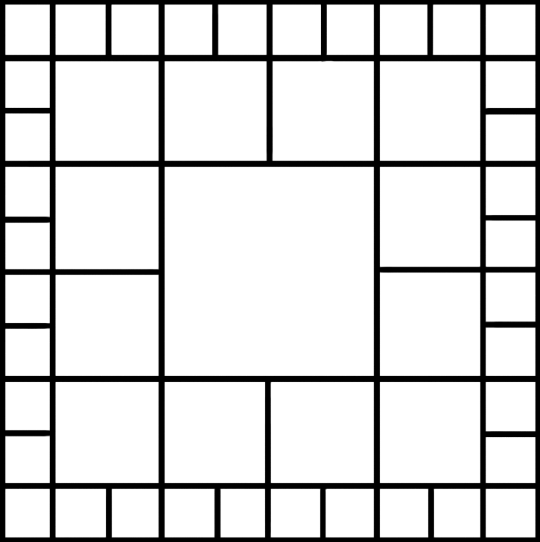
(If anyone reading this wants to give it a whirl, I reccommend blowing it up to x2 size; makes the small squares easier to work with.)
#memes#MEEEEEEEEMES#bnha#sousou no frieren#helck#magical girls and sundry shounen#small nonweeb corner#gundam ibo#fate whatever#sorry to the non-mutuals for the random tag-in#thank you for your fic/your meme grid and have an amazing new year
13 notes
·
View notes
Note
What's the problem with Deku's writing?
well for one he's a main character. which is strike one.
technically that's a joke but also not. there's a lot angles i could take in order to complain about deku, so for now i want to take the angle that as a main character, there are things that are going to be taken for granted as endgame for the narrative, but it's so taken for granted that the story forgets about the actual material needed to reach the endgame.
i'm going to use ofmd s2 as an example of this, because it's another thing i like to point at and go :) bad writing. so for that, it's very evident that the writers are aiming for "ed and stede are together and are ready to embark on a new, more mature phase of their life together". you can tell this because the showrunner was constantly talking about it in interviews. and indeed, the season ends with ed and stede parting ways with their crew and pirate life to try their hands as innkeepers.
but to reach that endgame, the series has to a) get stede and ed back together as soon possible, meaning they have to lean heavily on coincidence rather than any real efforts on the part of the characters, b) resolve the very emotionally stark situations the characters had left s1/started s2 in a way that makes the happy innkeeper endgame possible, but this makes the segue from drama to resolution unbelievable because the series can't really dedicate the time to dealing with that fallout before hopping onto the next big issue, which c) means that the ways that the other characters have been hurt as a result ed and stede's relationship drama have their pain sidelined and shrugged off, and in turn d) the focus on ensuring that ed and stede are together and in love means that their relationships with other characters get de-emphasized and feel much less lived, which rebounds and makes ed and stede feel more one-dimensional without the magic that fleshed them out. and most dire of all e) the audience is expected to believe that "sorry i was a dick" "you're not a dick life's a dick" is meant to indicate a development of maturity that means they are able to go off and be innkeepers together. it is NOT there.
essentially, the focus on a specific endgame without care about how that endgame is achieved ends up undercutting the triumph and catharsis of that endgame, rendering it much more hollow. people still enjoyed ofmd s2, and they're allowed to! but they enjoy it because their otp ended the season standing next to each other. three feet part. not for any genuine critical acclaim.
it's a similar issue with deku, especially in this final arc. his obvious endgame is that he'll affirm shigaraki's humanity and pain, "save" him (what that looks like yet, we don't know), and in turn become the greatest hero. we've got all the bones of that - just recently in 411, deku did his whole "you ARE human" declaration. but the lead up to deku and shigaraki's confrontation is thematically shallow and heavily dependent on us knowing that deku is a great kid and a great hero.
deku starts the third act realizing that if he understood the villains that he's faced, things could have turned out differently - the set up is that deku has to understand shigaraki as a person in order to stop him. the lead up to this is. well he asks muscular "what's up with you" one time in the middle of battle. that didn't work out. and then he had his nagant confrontation, where he was more shocked about her killing the former commission president than he was about the commission ordering a lot of evil assassinations. and then never thought about what that meant for society at large. and he was just like "well i know the world has some greys in it now" and that fixed her i guess. overhaul was there and deku made no real effort there to get why he was so frantic about seeing his boss. and then he has that conversation with ochaco where they both go "isn't it crazy that we have empathy for villains".
so basically the most work that he actually put into "understanding villains" was with nagant, who is a completely new character who has the baggage of "hero commission assassin is ANYONE in series gonna talk about that", and the potential she possesses as a shigaraki foil and a stepping stone for deku towards his endgame gets muddled. she's also basically, while a significant confrontation, is one beat of many in the third act.
so the set up for "understanding villains" as a factor in deku's endgame, in seeing villains as human, is pretty weak. and deku was honestly really dependent on getting that build up and using other villains as a learning experience, bc his actual dynamic with shigaraki is sparse. compare it to uraraka and toga - the "understanding" thread fares a lot better there, because uraraka has had specific and charged interactions with toga that deeply affected her and made her think. deku's most constructive interaction with shigaraki was way back at the mall, before the training camp, but that's not enough to carry chemistry through their supposed arc as hero & villain.
but the story already knows that deku, one way or another, is meant to succeed, so it acts like he received the necessary development to be able to understand shigaraki as human in their confrontation.
there's a similar lack of meat for many other aspects of deku's characters - like his relationship with the vestiges, where yoichi could be 2nd and 3rd around on deku's behalf, and his mastering of the new ofa quirks, which we get TOLD has consequences or that he's struggling with, but it's never in a way that actually causes him substantial issues that he must overcome.
but actually, we can move all of that aside and ask one simple question about deku's character: what does he think about the floating death coffin the other heroes built for shigaraki?
deku gets confronted by the vestiges about having to possibly kill shigaraki, and his response to that is "yeah i guess but i gotta try saving him". which is very nice, but it just ends there. deku doesn't have to deal with how everyone else - people who are scared, or have been hurt by shigaraki and the villain's actions - might feel about this initiative. at no point does deku have to stand his ground against the other heroes after shigaraki's head, he doesn't have to convince anyone of his point of view, he doesn't have to look inward and understand why he wants to do this. it's just "well if i can!"
deku doesn't have to have any thoughts about the floating death coffin. he never has to be in scene with it before it started malfunctioning. he doesn't have to have any opinions about its construction, about the heroes deciding to take this path. he doesn't need to have feelings about it, he just has to save shigaraki.
and when that happens, the narrative will celebrate him, and the heroes will be like "wow deku really is the greatest hero, kids these days are so great". they don't need to have thoughts about deku wanting to do this in the first place, because it's going to happen and no one can stop it.
in a similar way that some ofmd fans can walk away happy with season 2 because they don't need anything more than their otp standing together three feet apart, a lot of fans would be happy with deku and shigaraki's likely endgame because what matters is that deku is the hero and that he saves shigaraki. but from where i'm standing, deku has so little substance and build up to this endgame (or at least the build up is THERE, but poorly done) that it's hard for me to be impressed.
also everything @codenamesazanka said here. everything she says i nod and go hell yeah.
#i'm working on a few things for posting soonish#ask replies and a 2023 favorite character meme#but in the meantime just let me point at ALL this and do ALL the nodding#other peoples' meta#no. 2 green#god forbid he ever have to face down a real-life adult who can bring down real-life consequences over his heretical Saving Villains opinion
32 notes
·
View notes
Note
Man, I'm glad I don't do chapter posts anymore, otherwise I might have to spend actual time articulating why this whole chapter is fit only for the spinning bladed death of an industrial kitchen sink garbage disposal. Because it's really gross, you guys.
It's lazy, too, of course, particularly with the way it portrays Yoichi, a characterization that only makes me more determined to play One For All really dark in any fix-it fic AUs I ever wind up putting together for this godforsaken endgame.
But like, I've spent years watching people in this fandom be flagrantly sensationalistic about Rei's situation and the language they used to discuss it, and always thought it was gratuitous, even borderline misogynistic in and of itself, particularly compared to the actual canon. In its depiction of Rei's attempts to exert her own, albeit limited, agency in the face of an arranged marriage and an abusive husband, the canon granted her nuance and dignity far beyond the way many fans talked about her.
There's none of that to be found here. It's just appalling wallowing in its fetishistic and sensationalistic gawking at a nameless woman victimized by her own unborn child and, even moreso, by an author who thought no further about her than to use her as a vessel to impress on the audience the monstrous, implacable, womb-to-tomb Evil of a shallow, masturbatory villain who presents less intellectual challenge than a Goofus and Gallant comic and on whom we have now wasted one hundred and twelve chapters and three goddamned irl years.
Throw This Canon Away And Don't Look Back.
afo mom lore is crazy it's literally the last thing I expected
I'm going to be honest, I find the writing choices around that tasteless at best, and really gross in general. It's one thing to sprinkle in some edgy melodrama as a part of the narrative's backstory, I can't fault that it has it's place, but this really upset me.
Personally, I go back and forth a lot on how misogyny and objectification of female characters manifests in BNHA, but one of the conversations I think about the most was how violence is depicted against female characters in comparison to their male counterparts, where Mirko was the central point of discussion.
I think about that discussion now, because "seemingly homeless sex worker is weakened by her Evil Fetus, dies giving birth in the elements, has her corpse preyed upon by rats and her own fucking Evil Baby" is frankly indefensible, and really emblematic in that connection between misogyny and violence. It's also just very immature grimdark lit with an unnerving fascination on the interplay of Sex and Violence-core.
The funny thing is I was telling @stillness-in-green after reading the final part of her Heteromorph & Heteromorphobia series and reliving how disappointing the Central Hospital mini-arc was is that I was thinking "well at least there's not a lot that BNHA can do to disappoint me to that extent again". I should know by now, never underestimate Horikoshi. Oh well!
#bnha#bnha critical#bnha SO CRITICAL#stillness has salt#stillness has mountains of salt#you've heard of that planet composed entirely of diamond?#stillness has a planet composed entirely of salt#jesus fucking christ horikoshi#bnha spoilers#bnha 407
77 notes
·
View notes